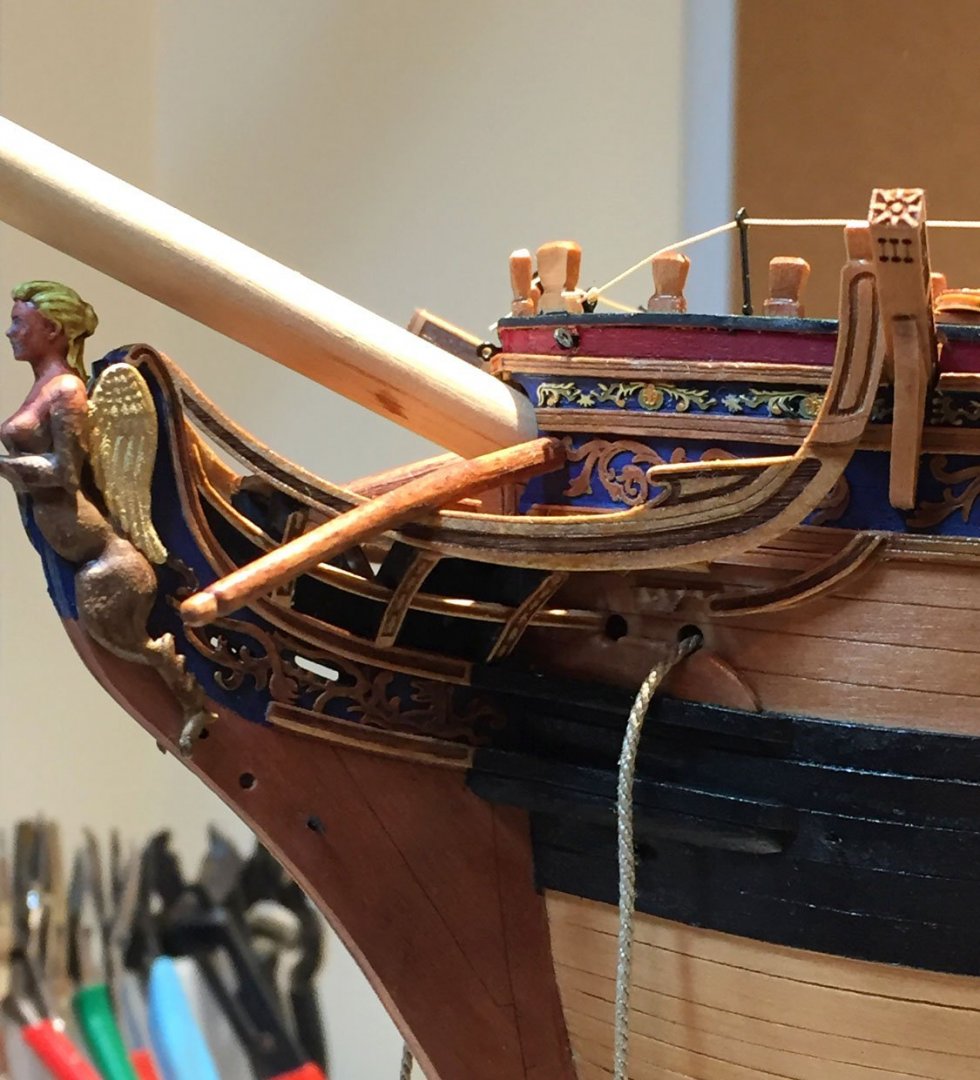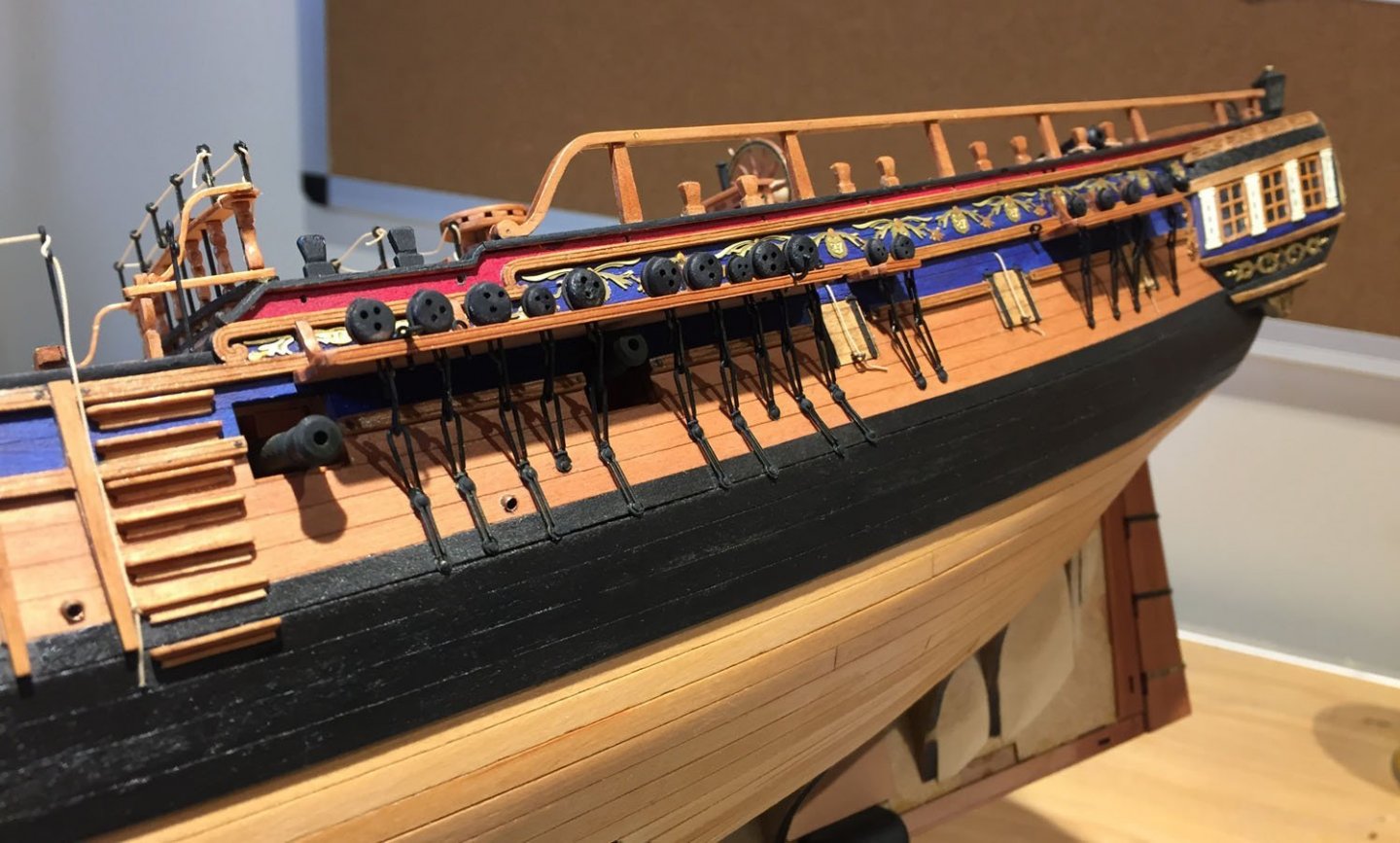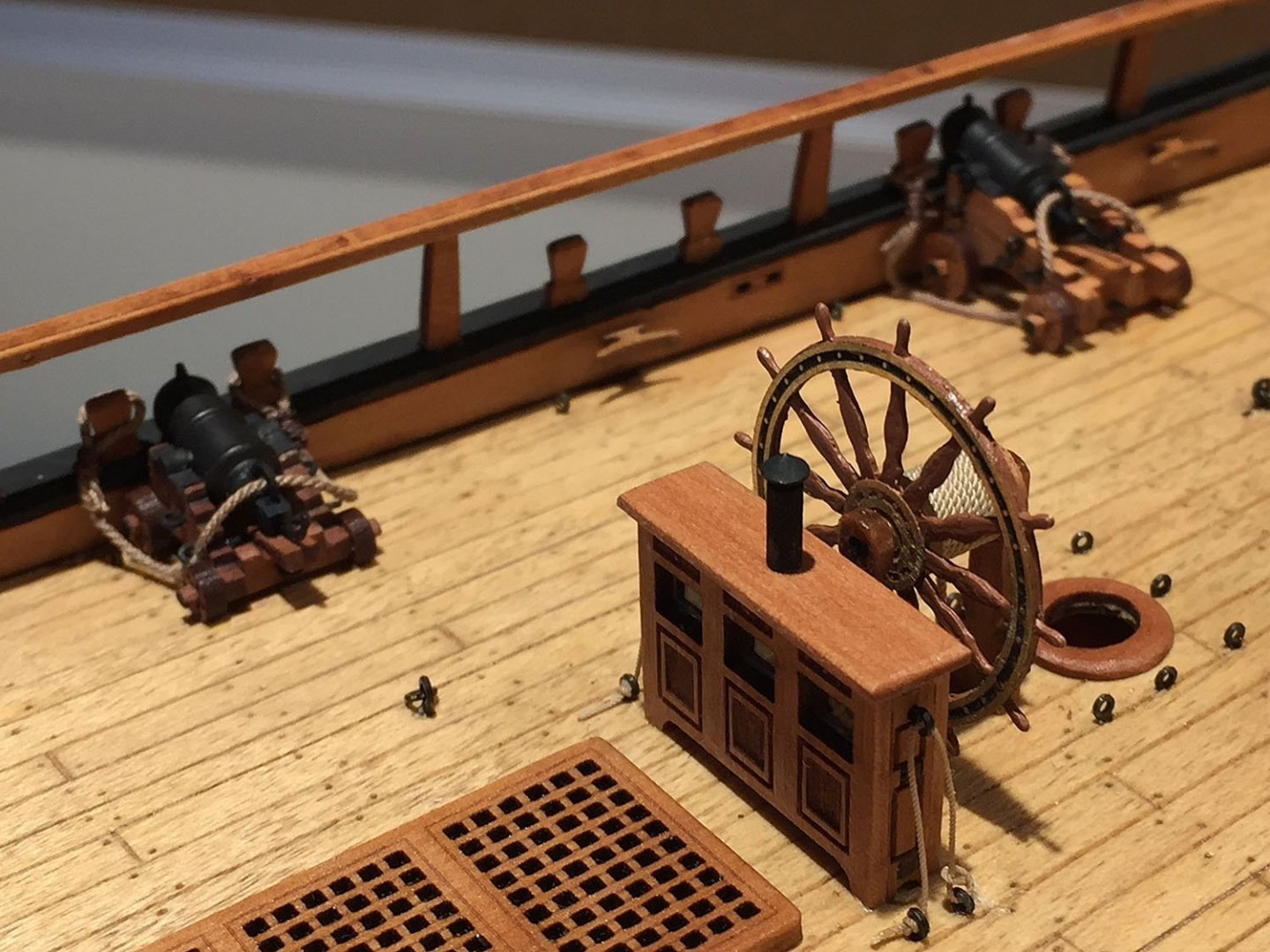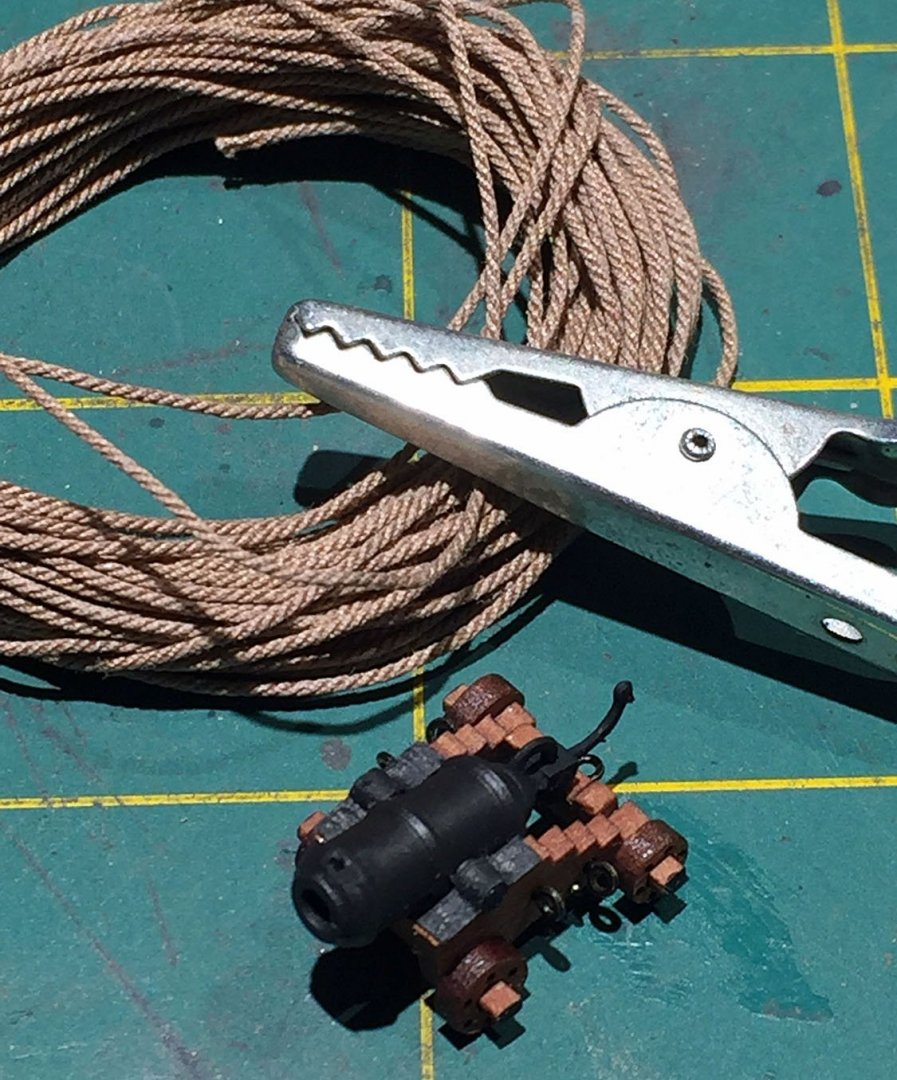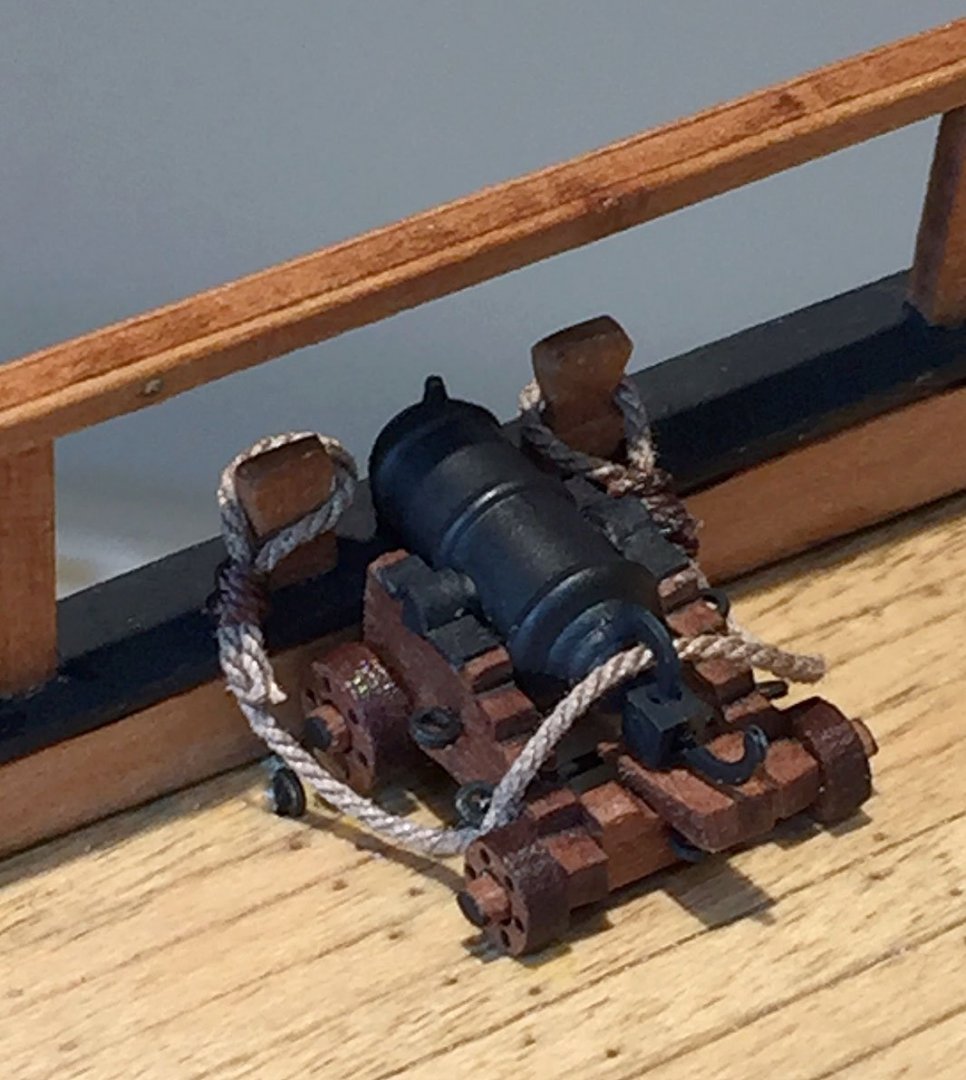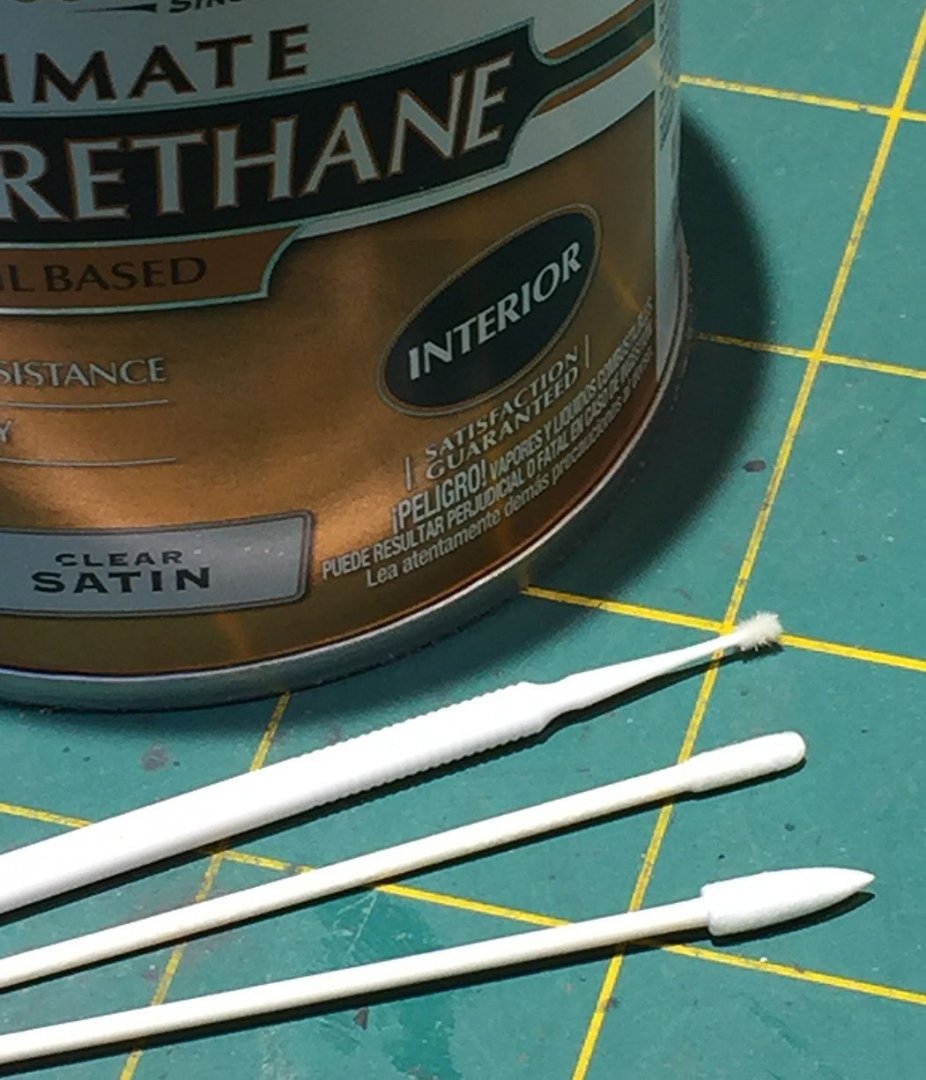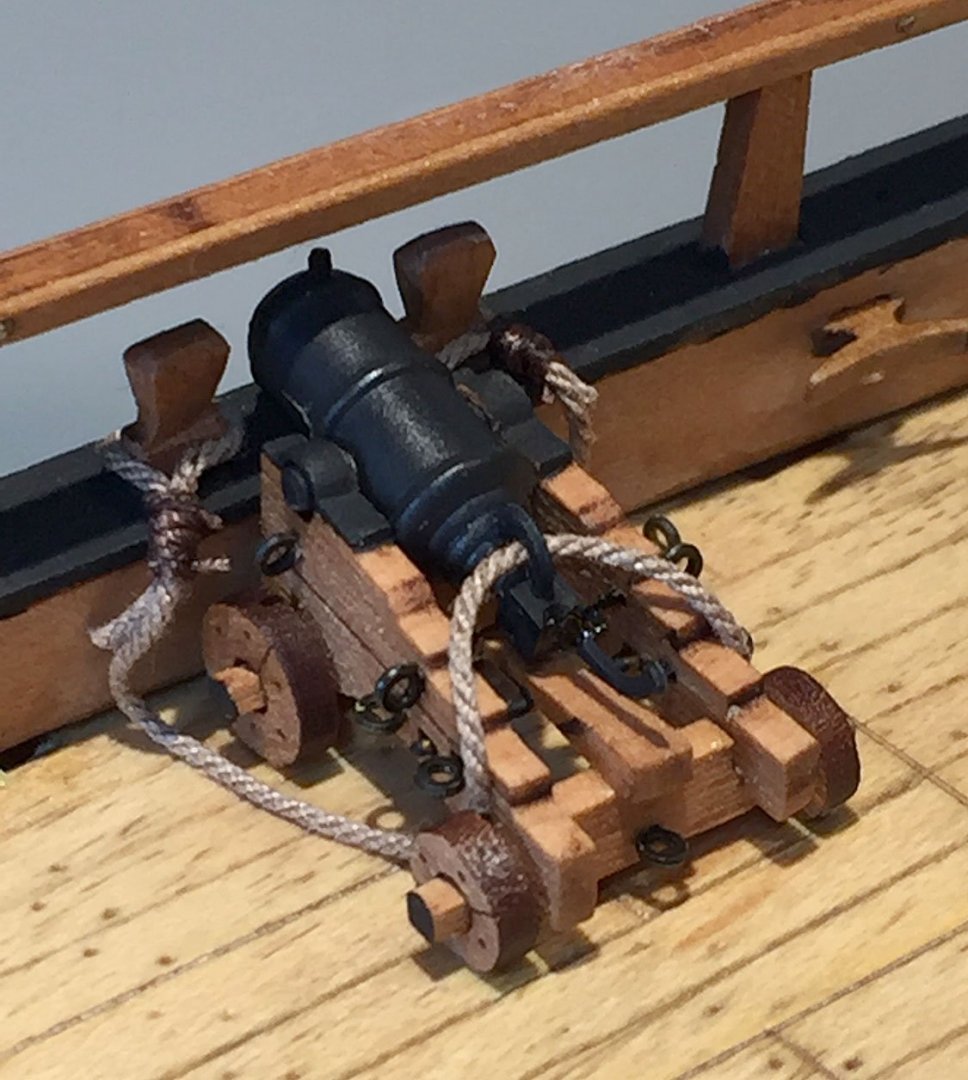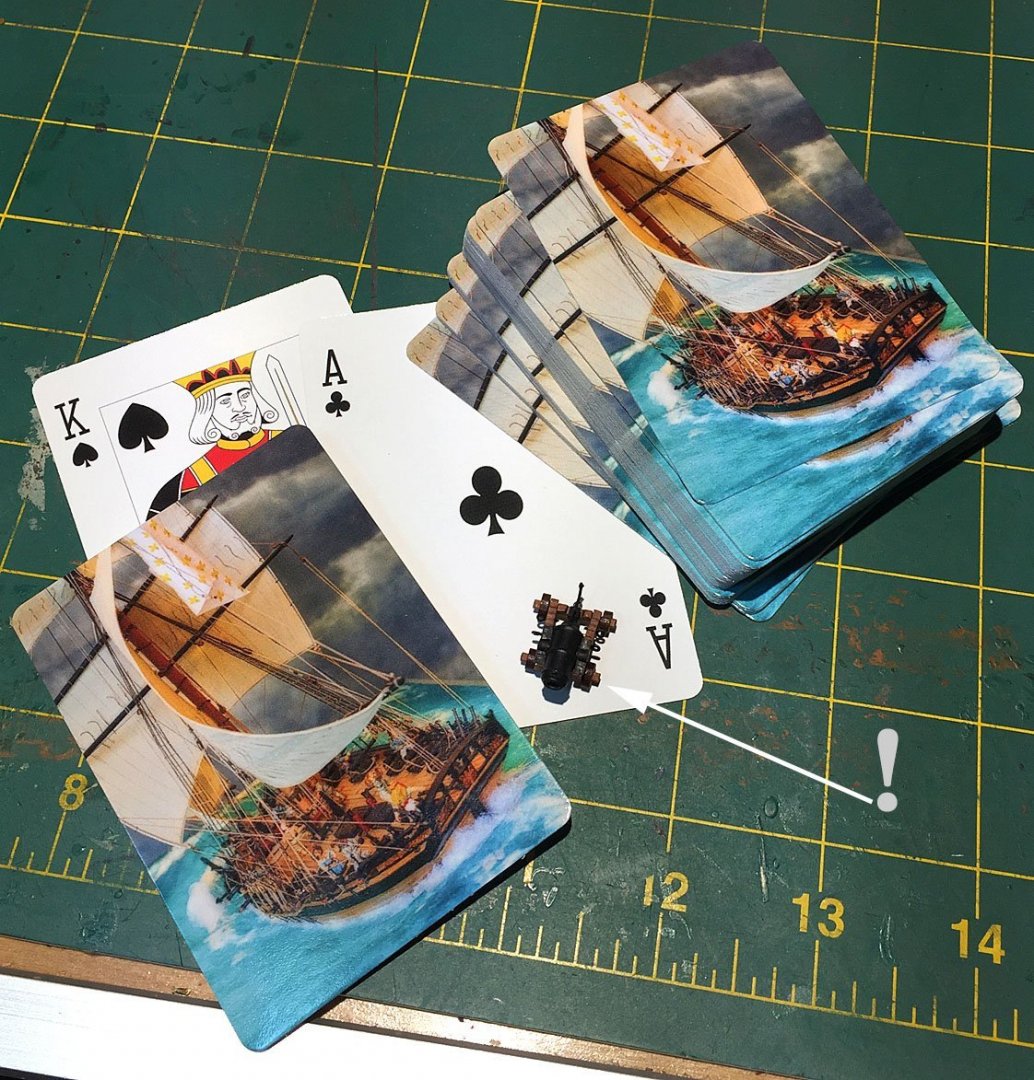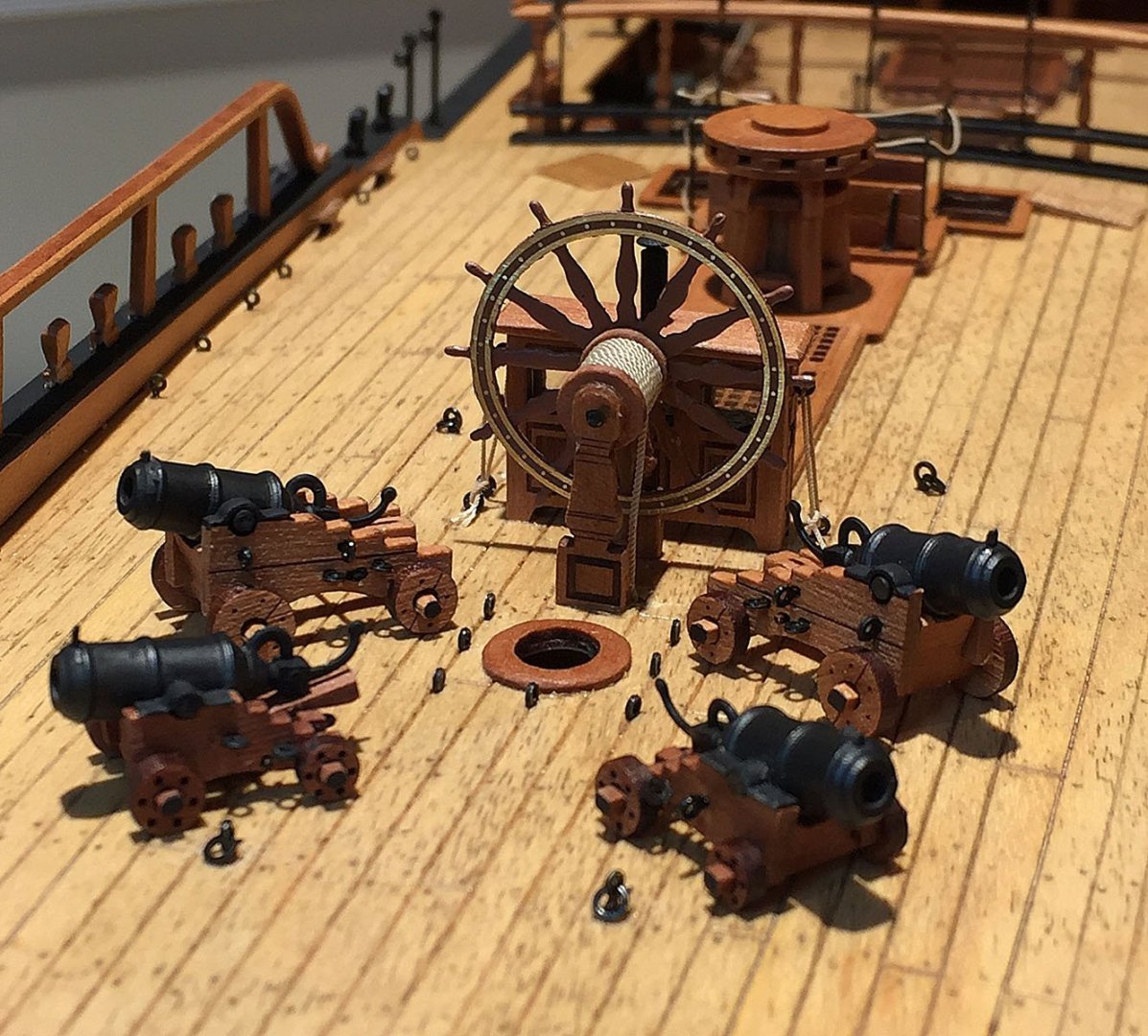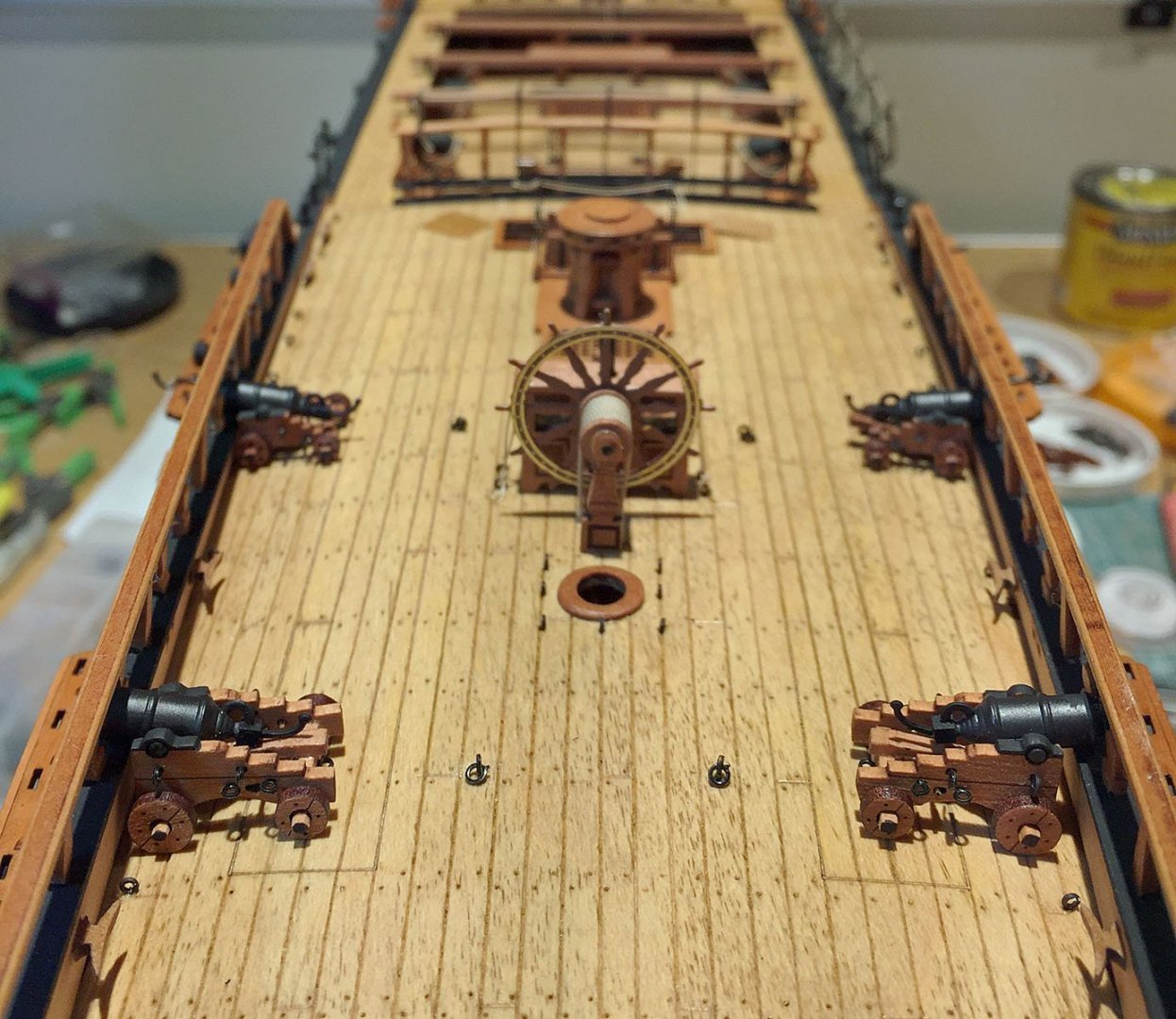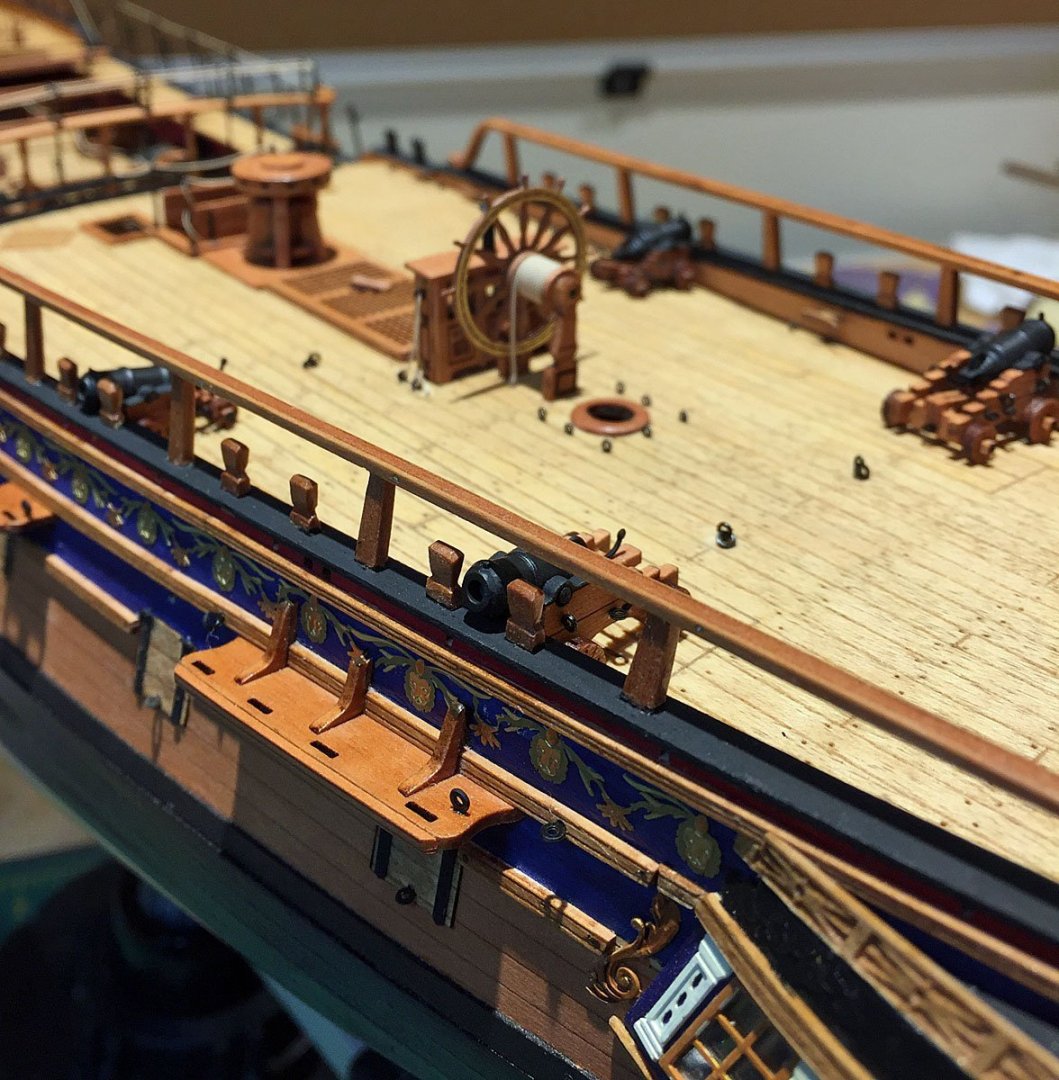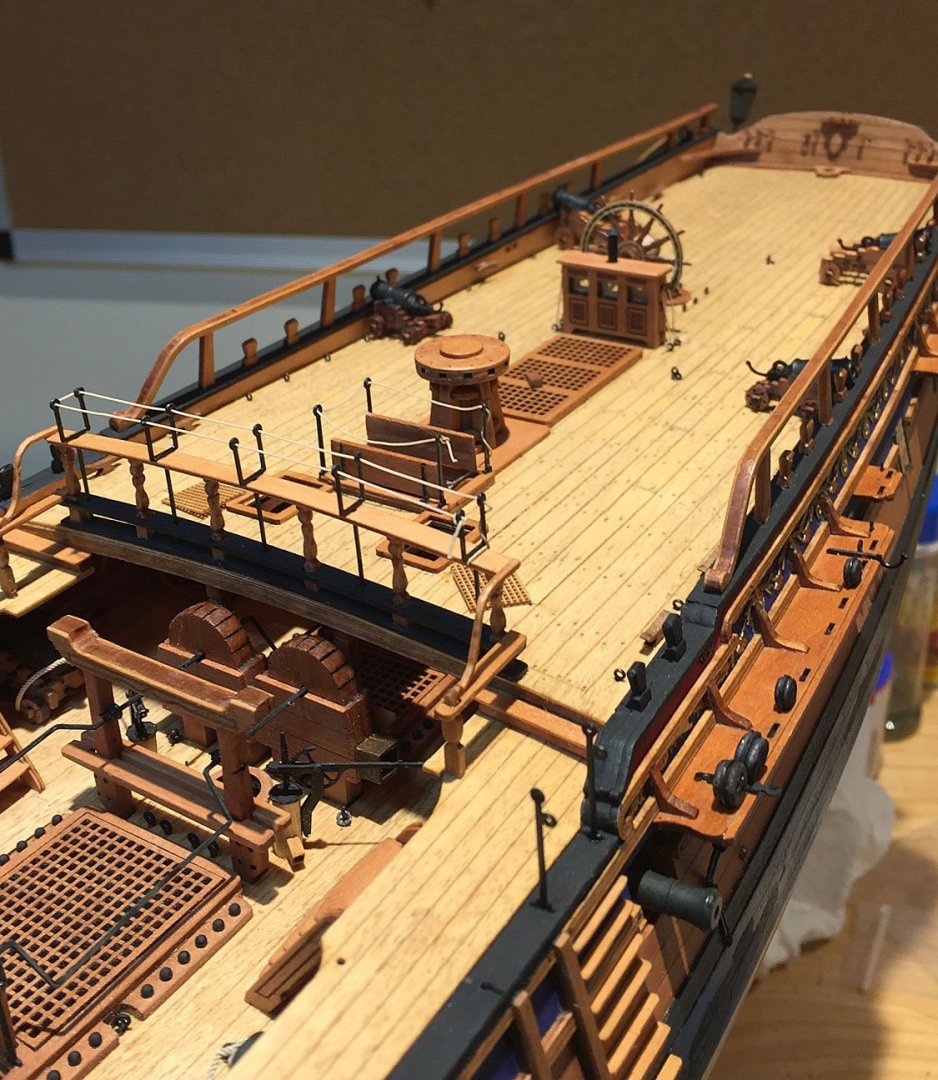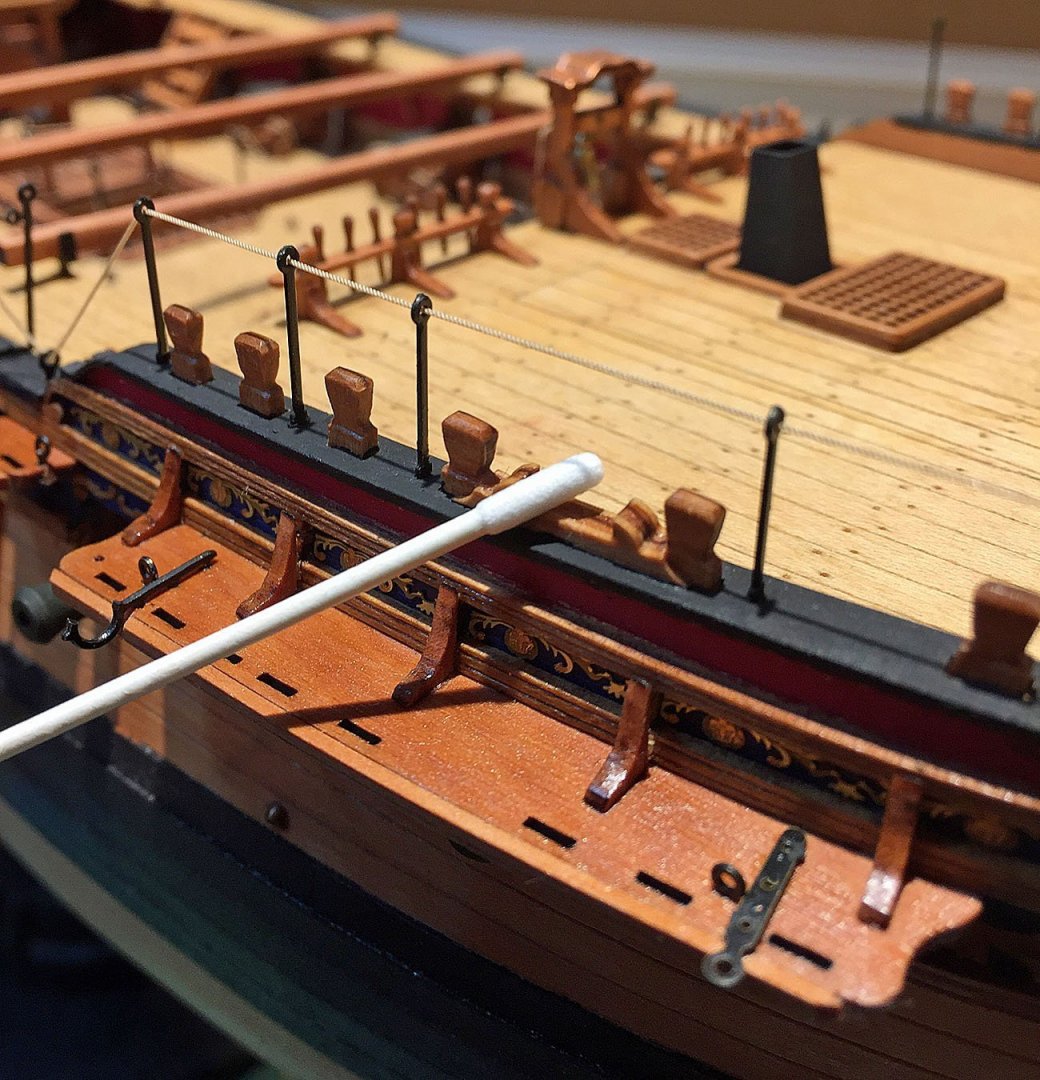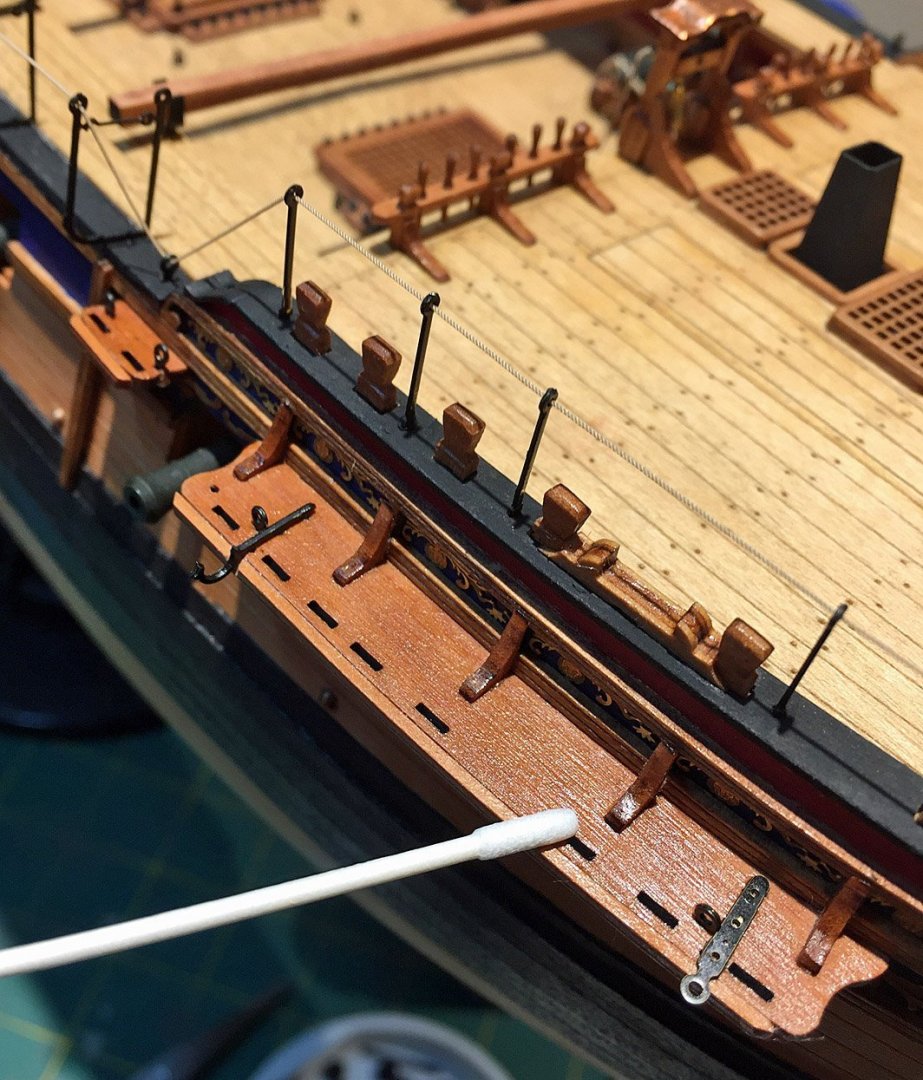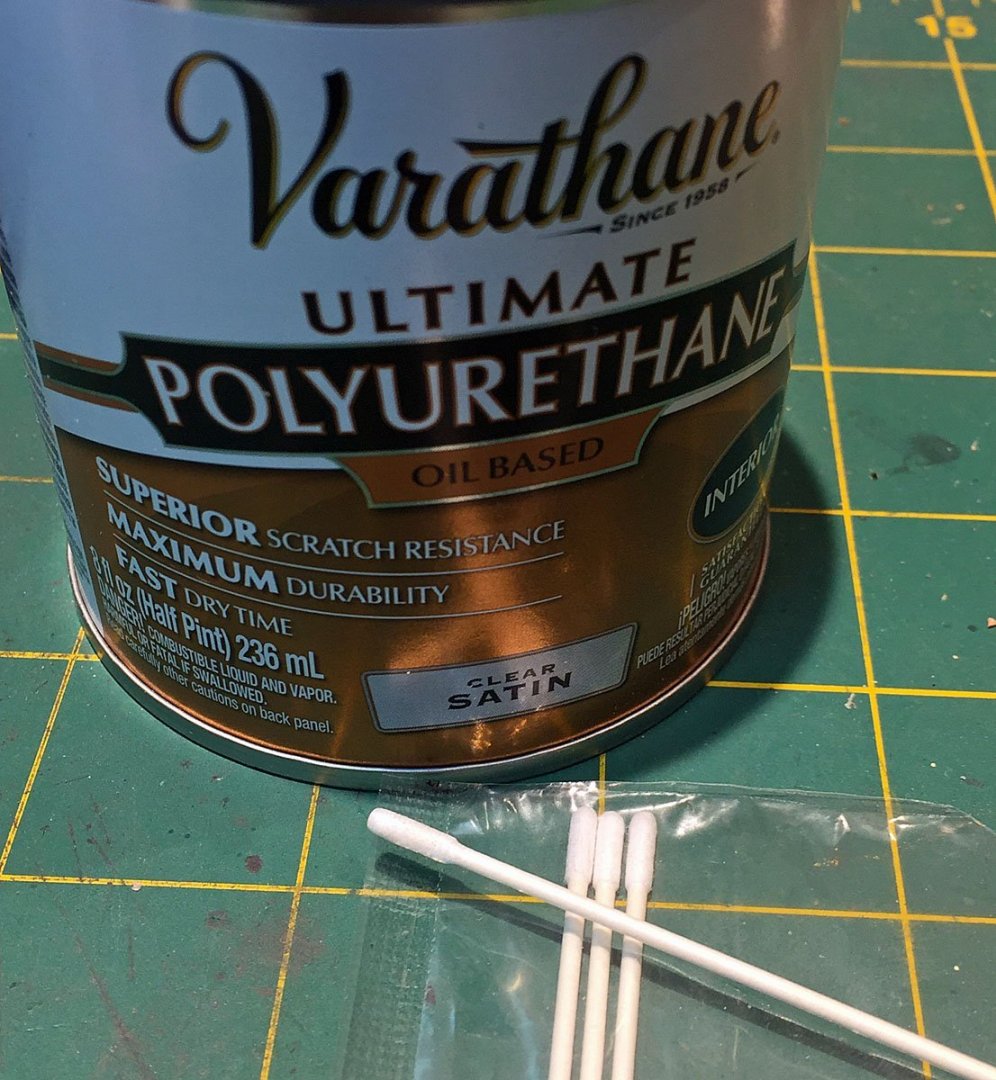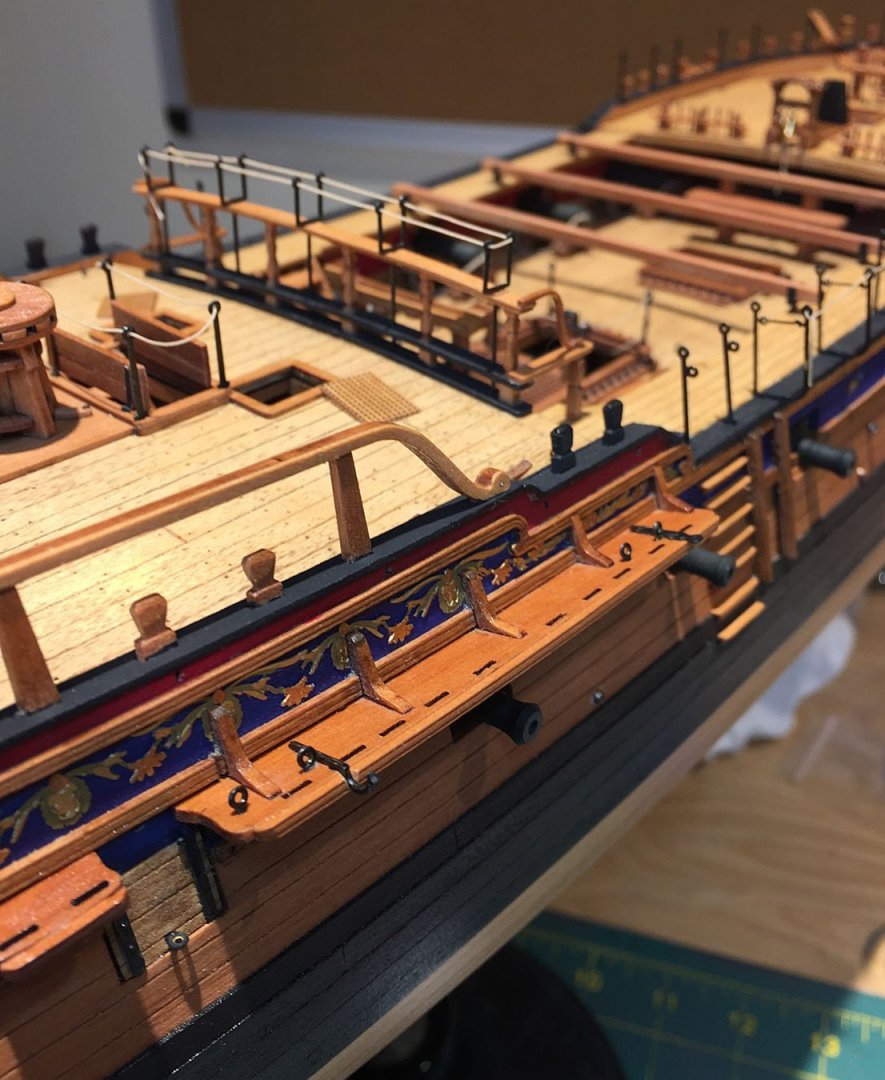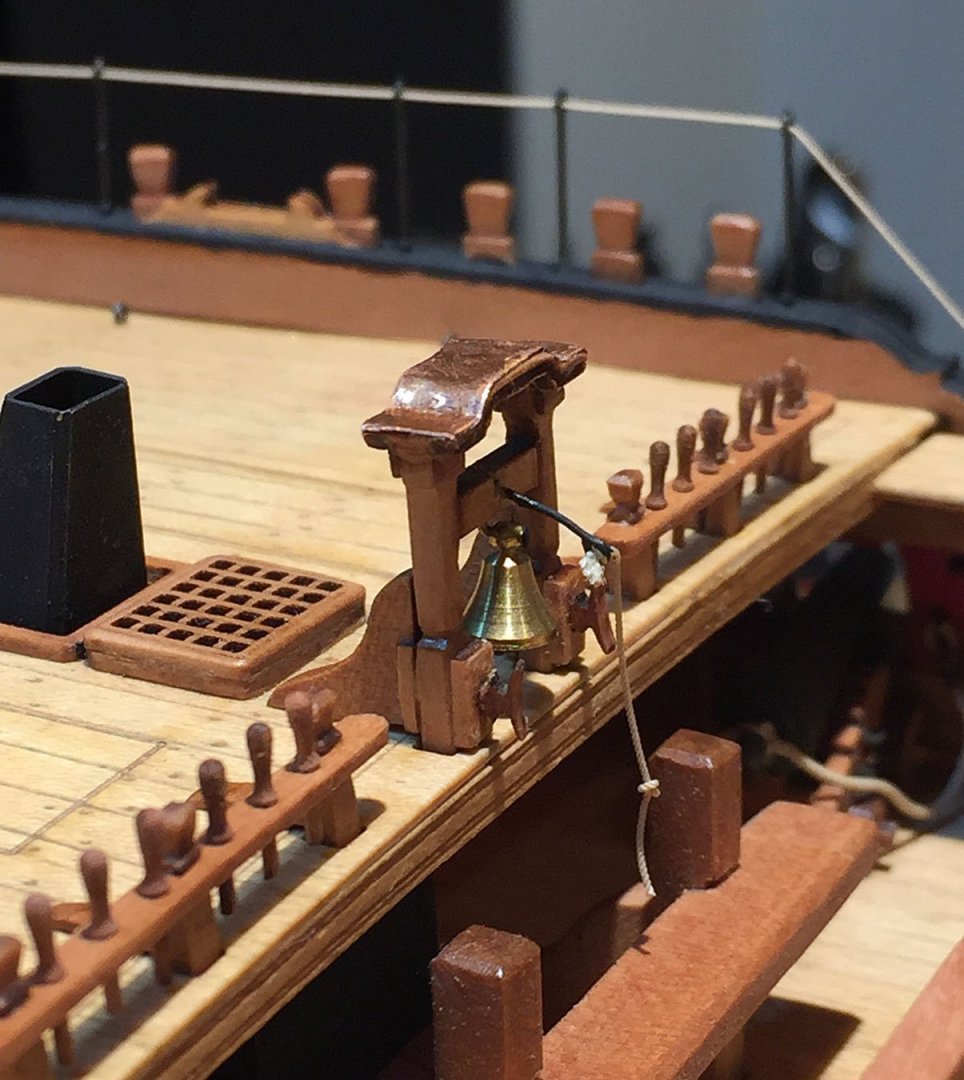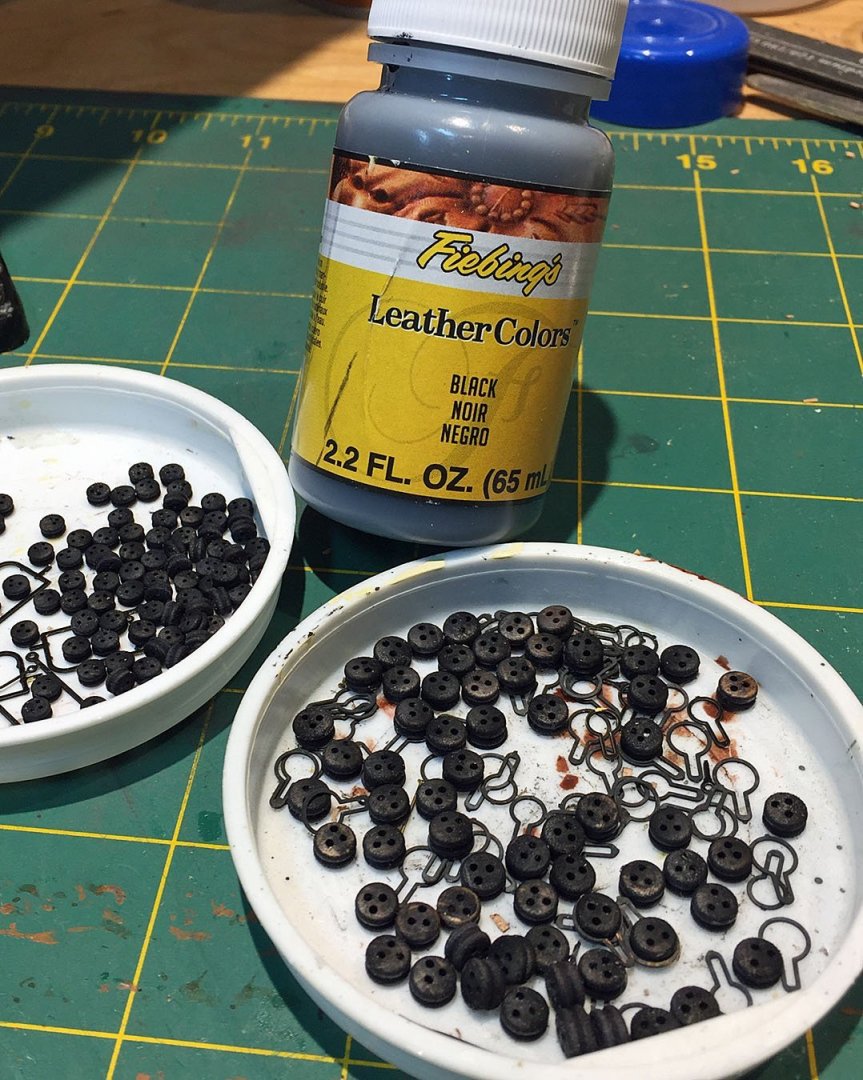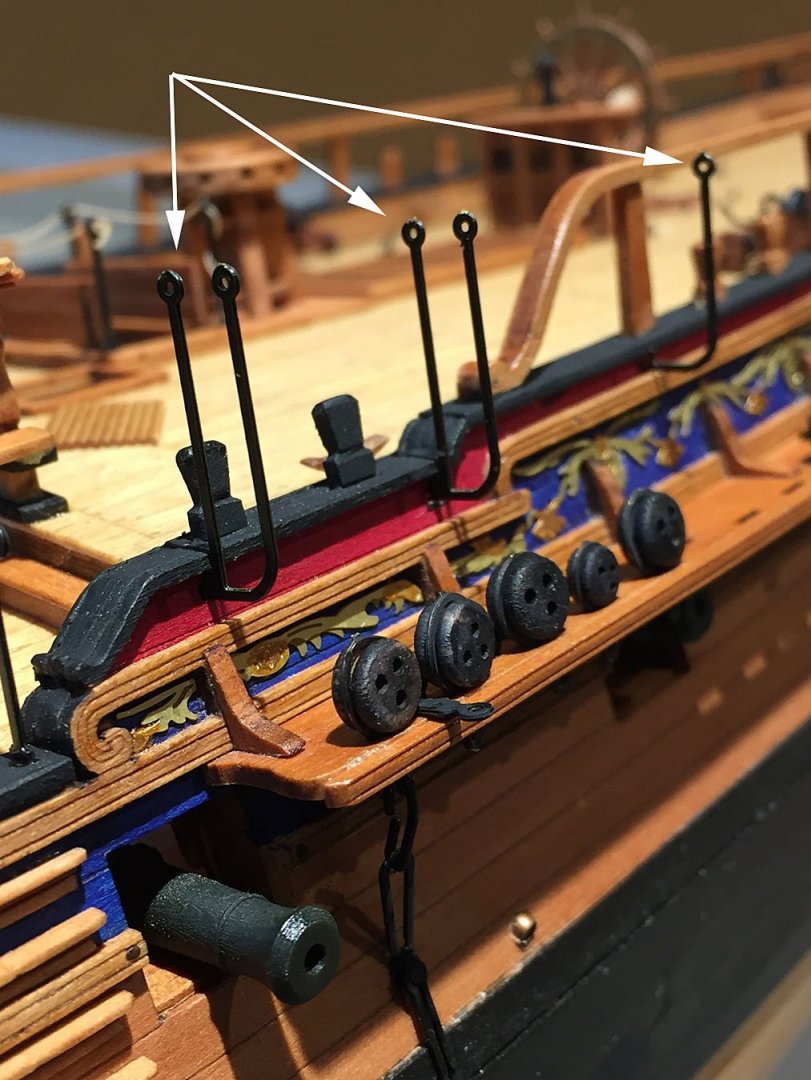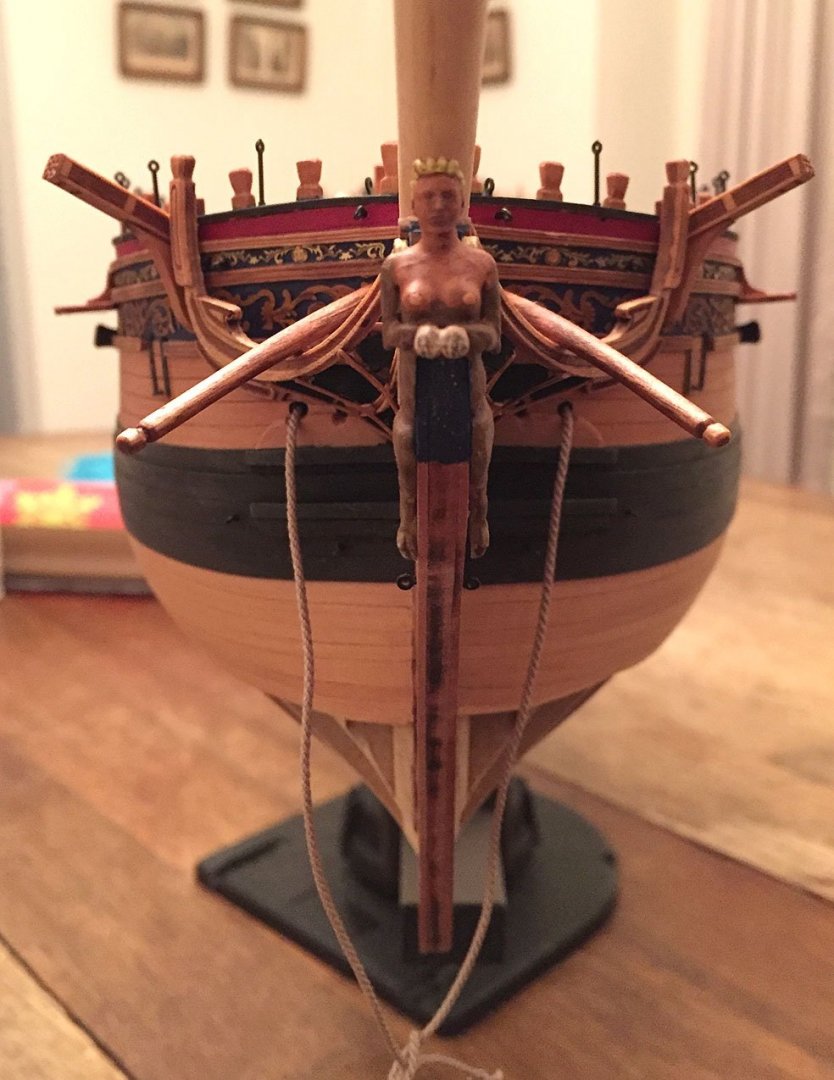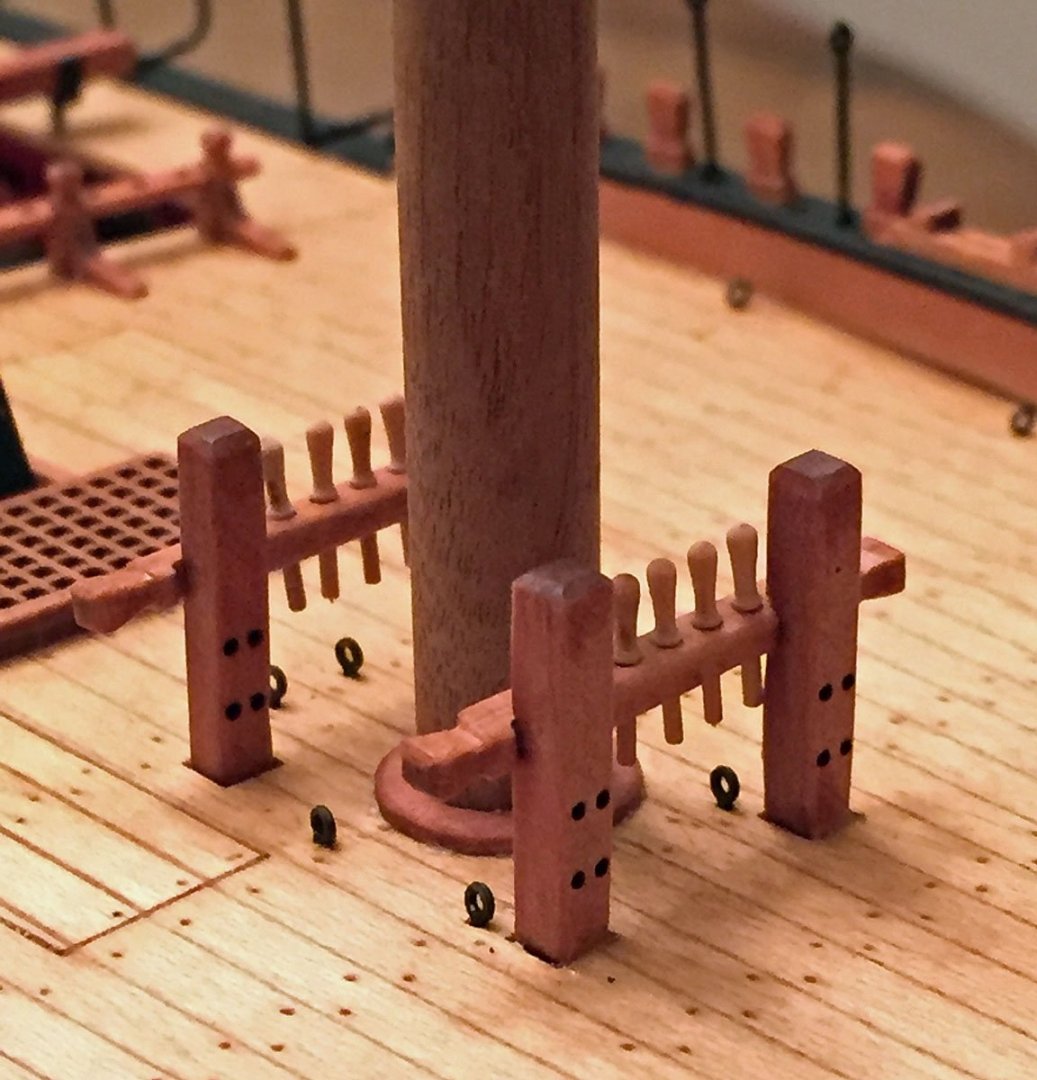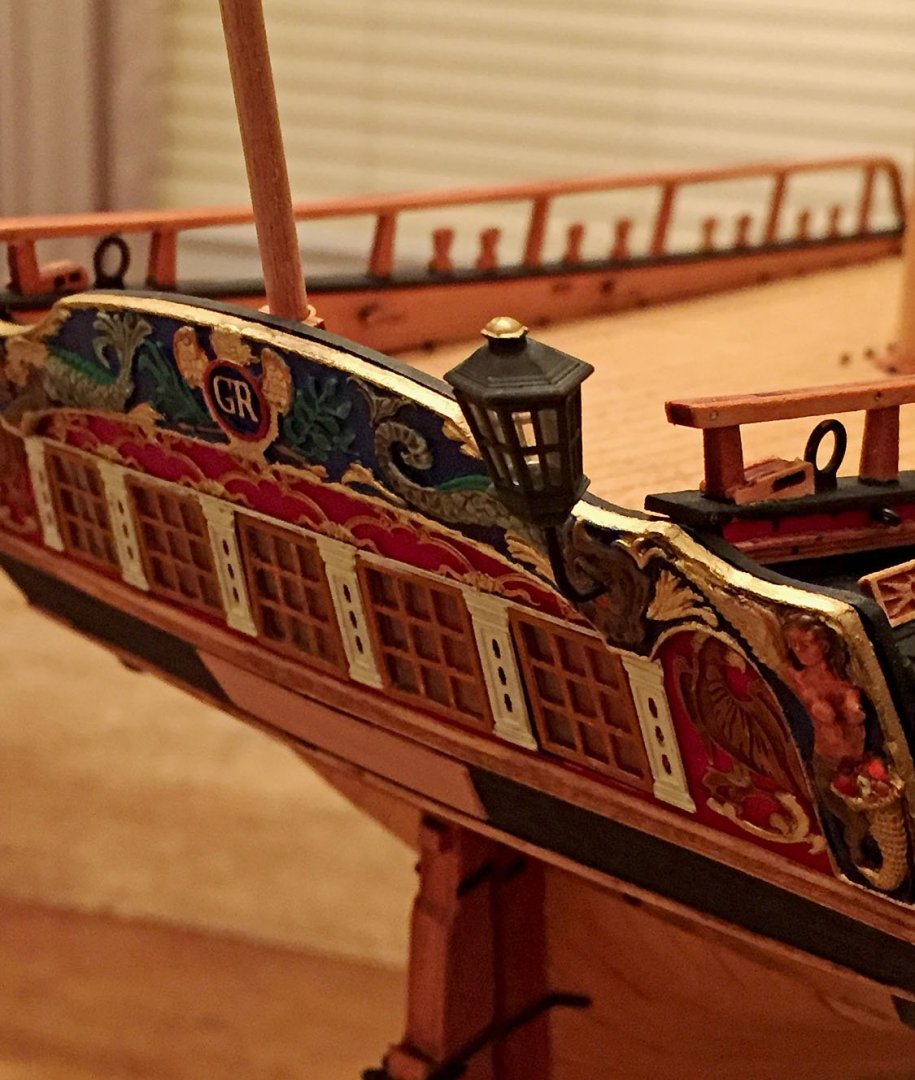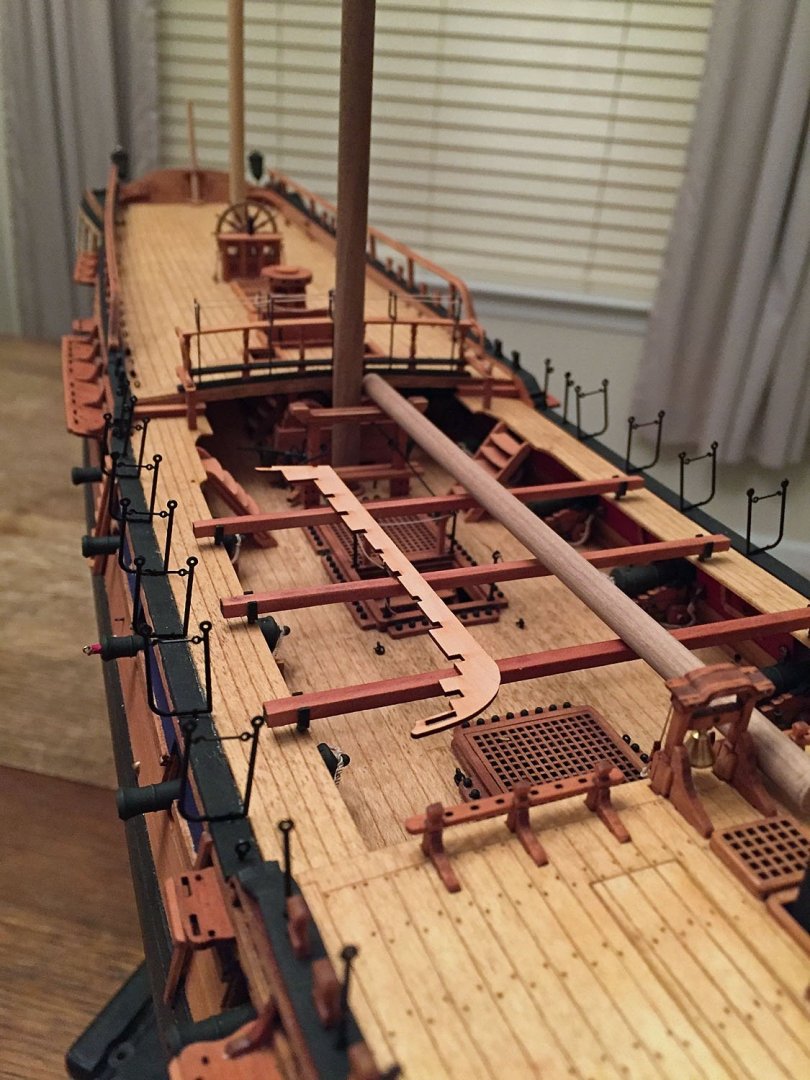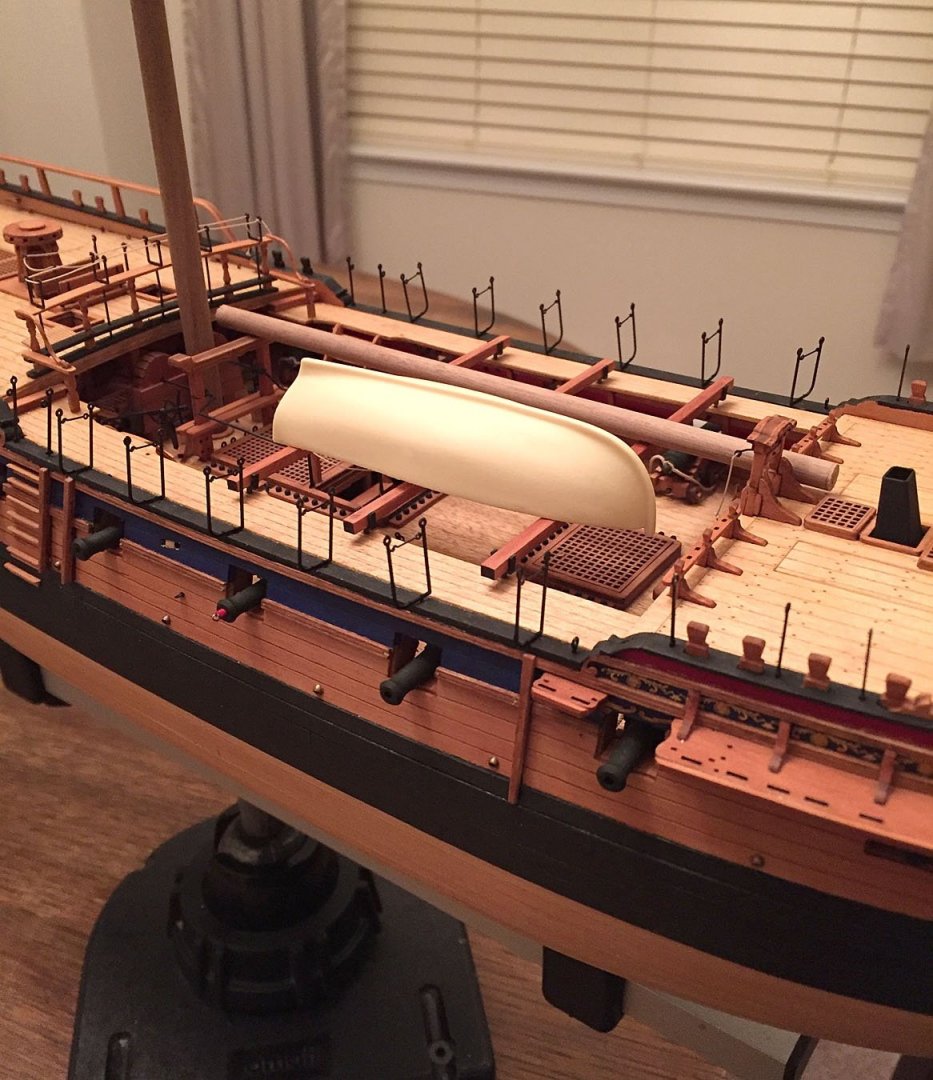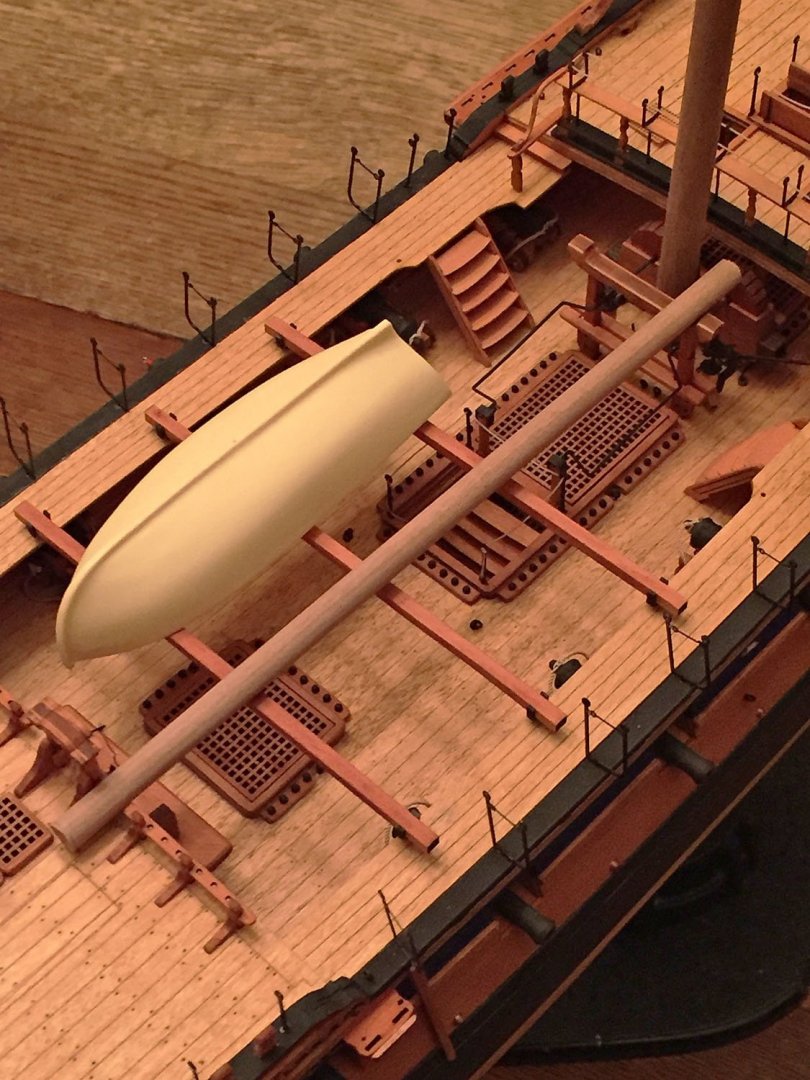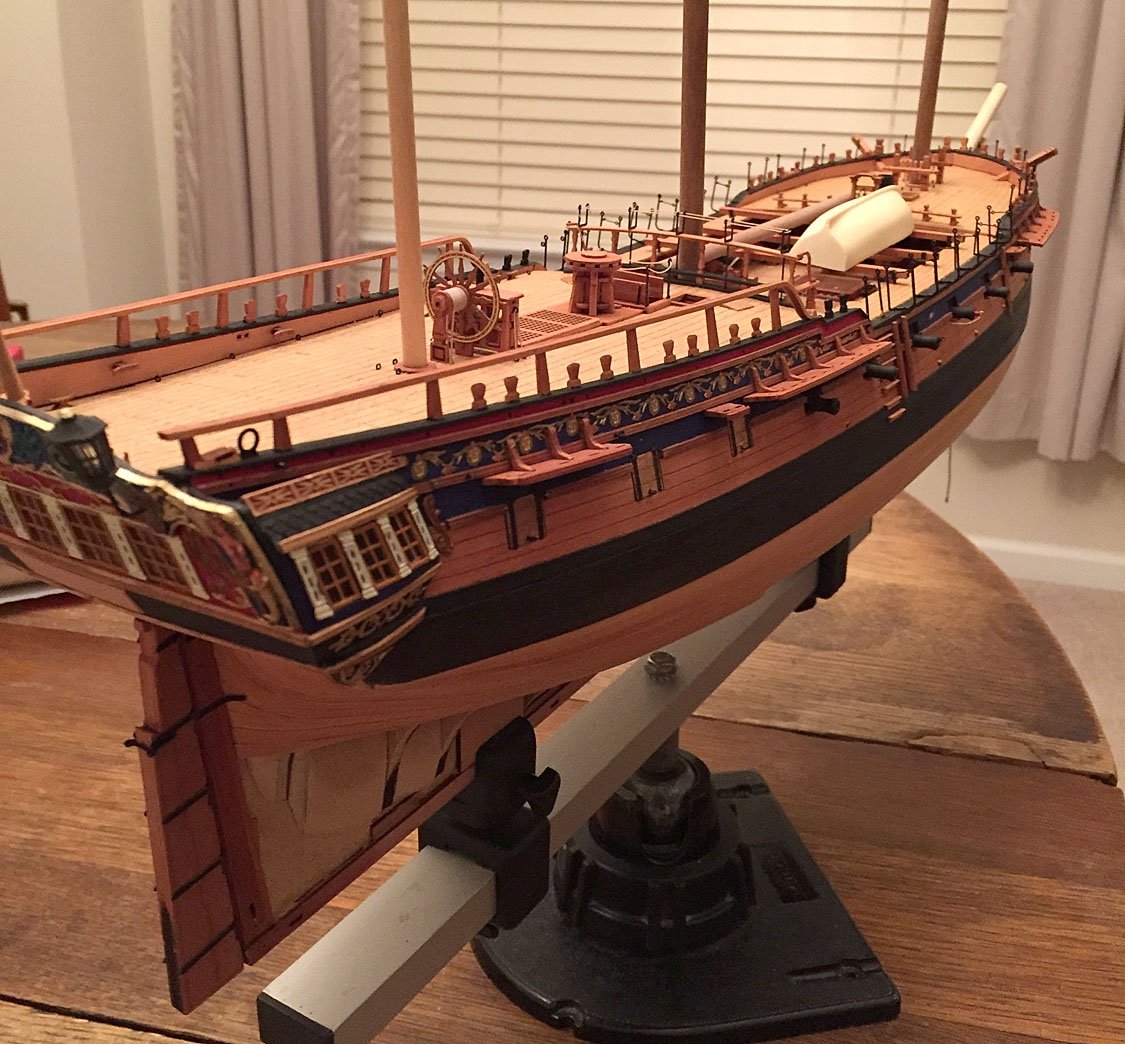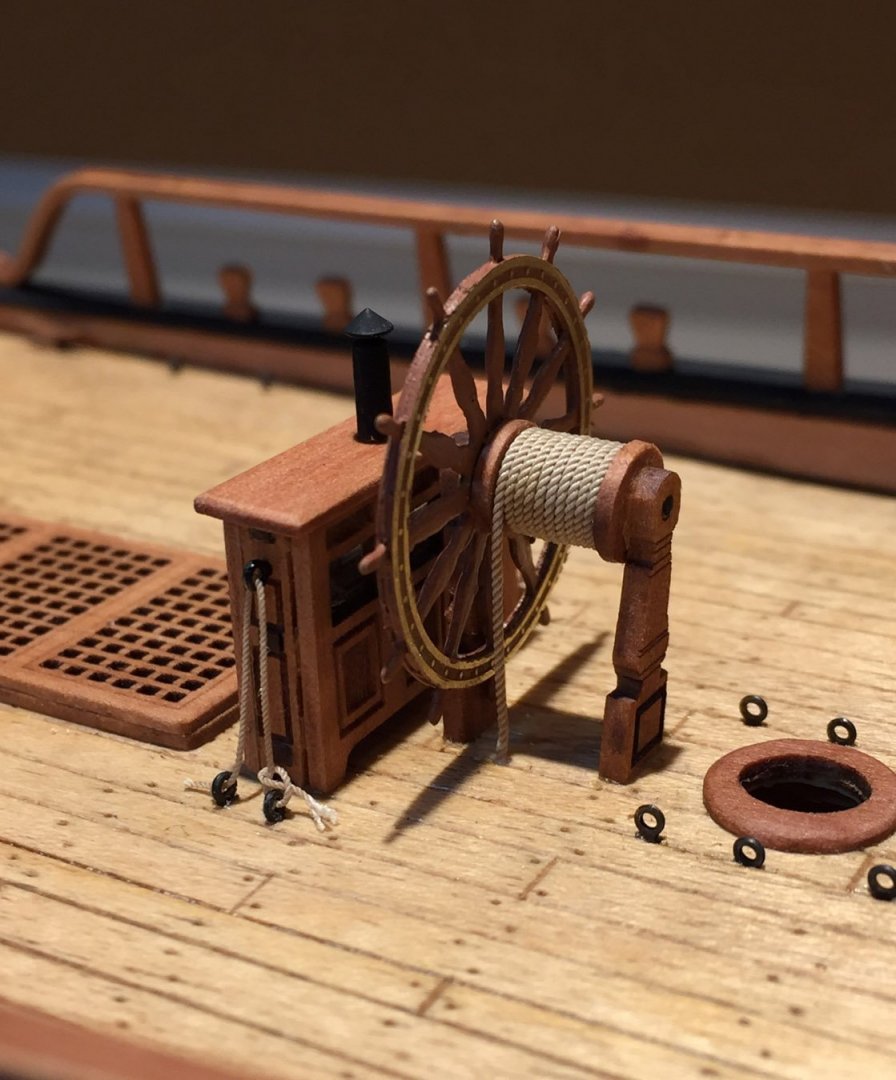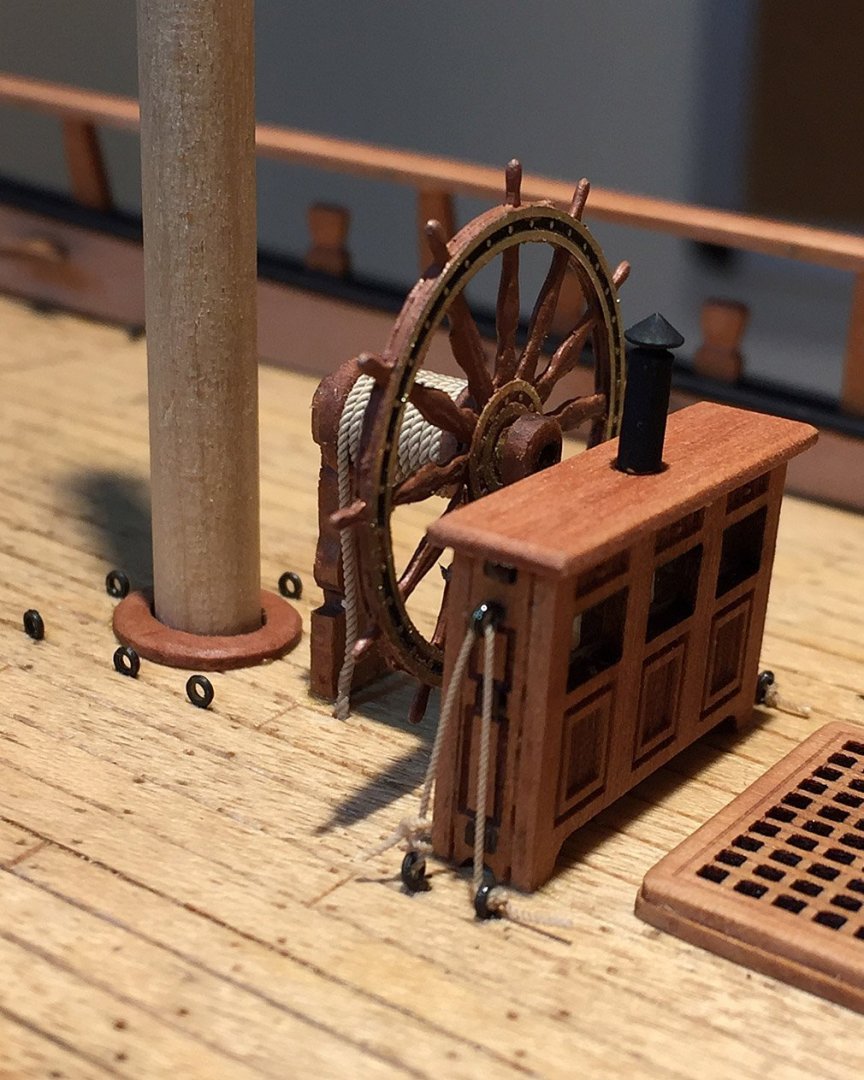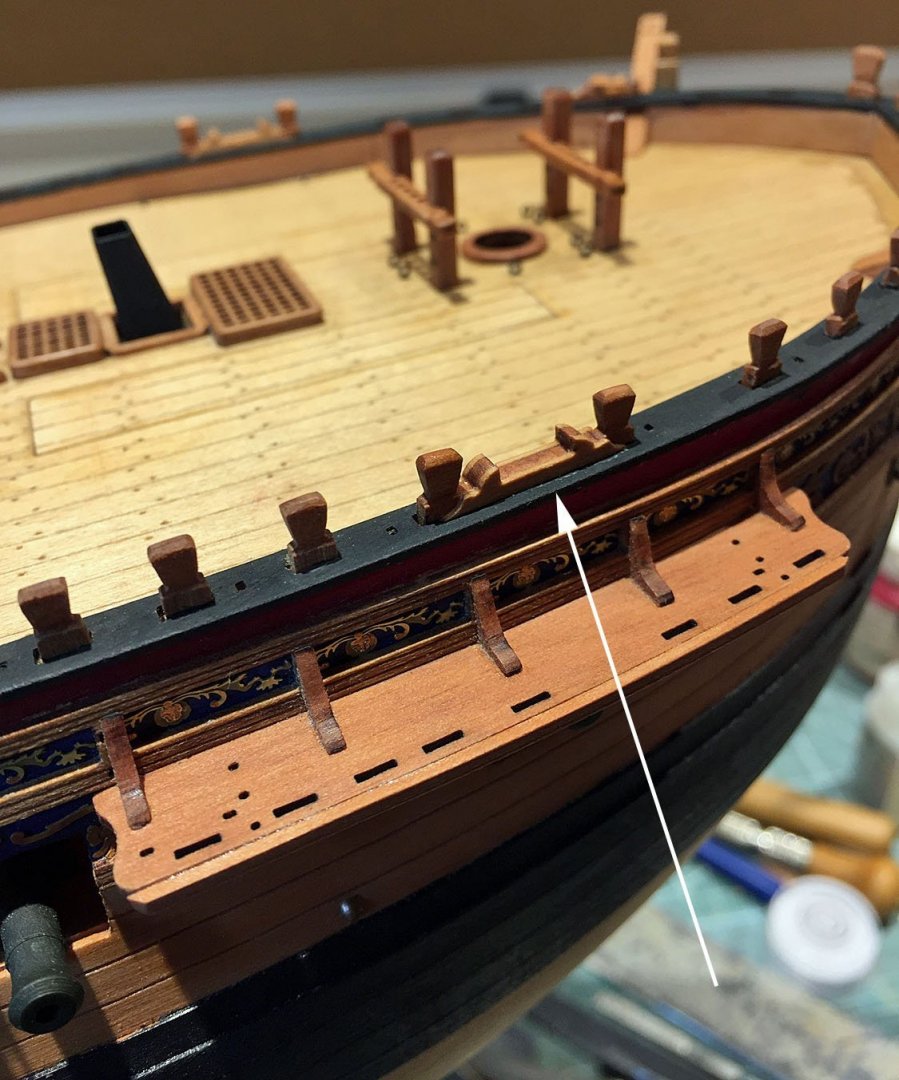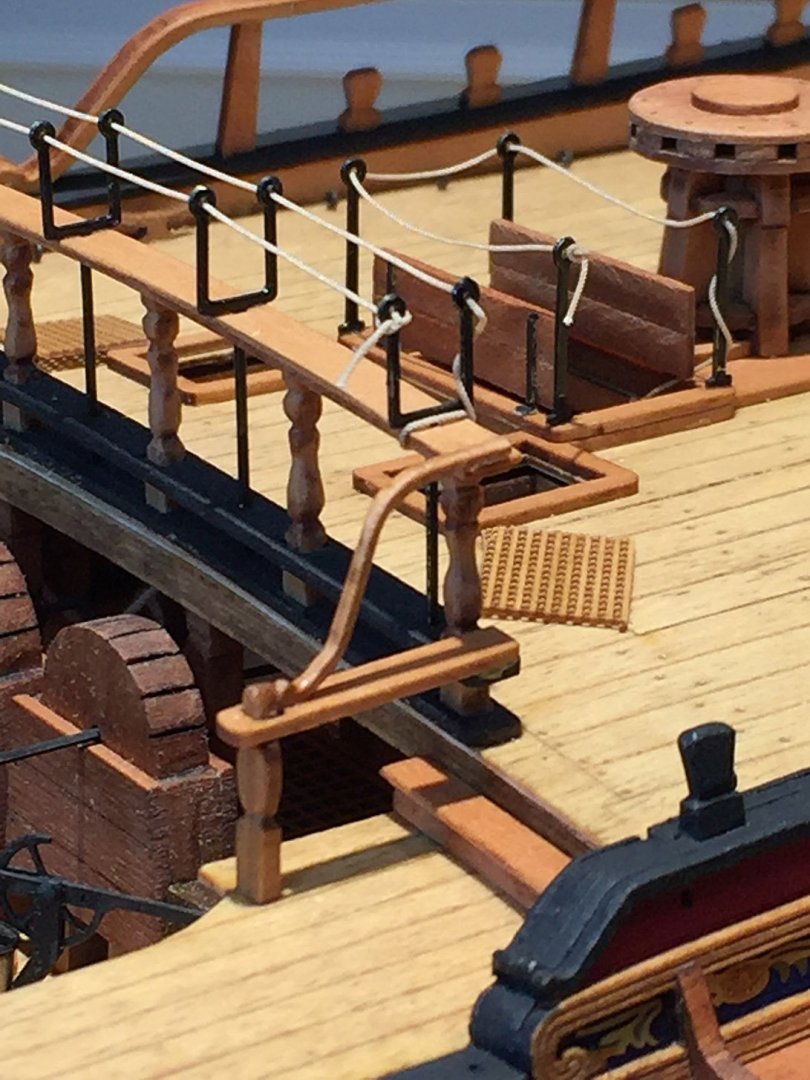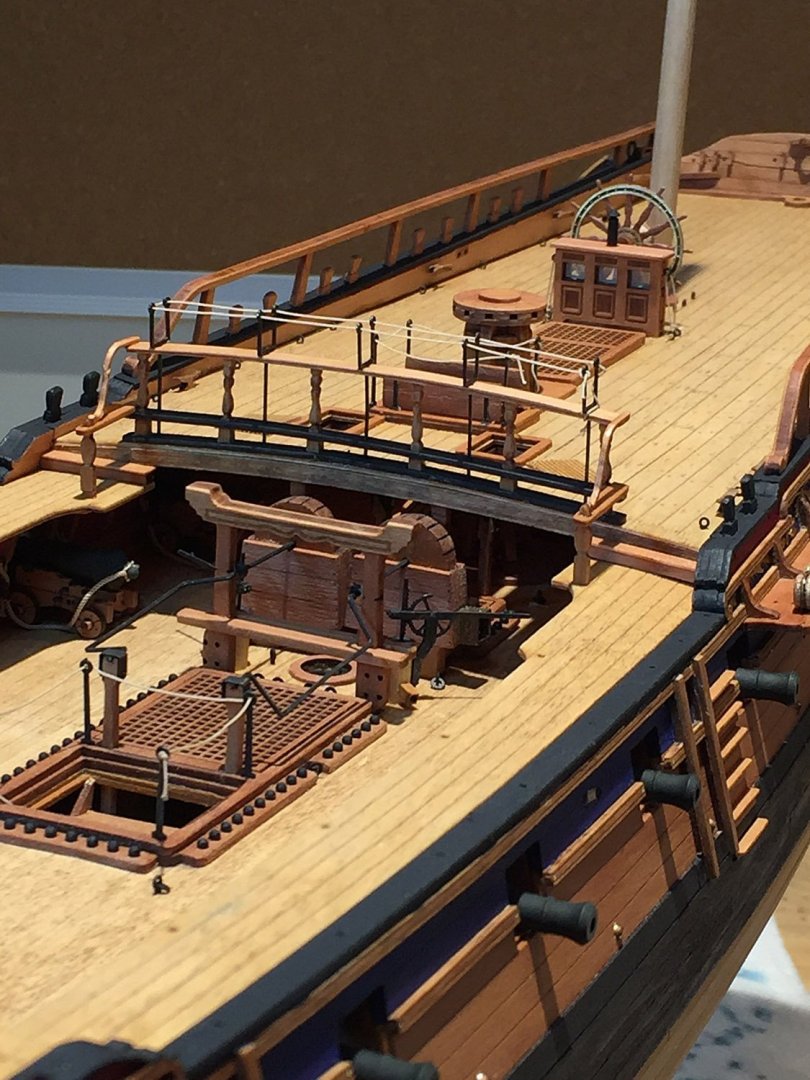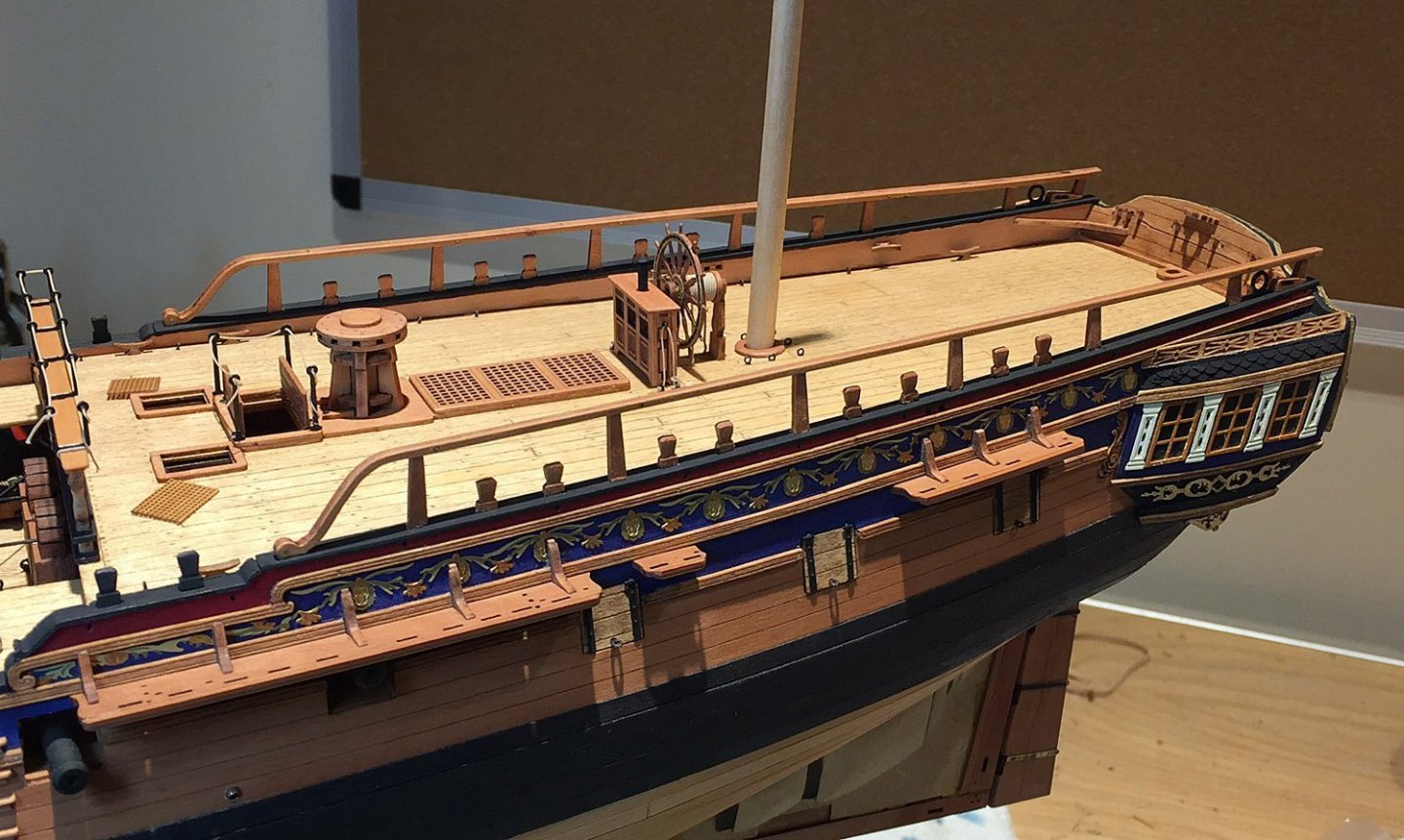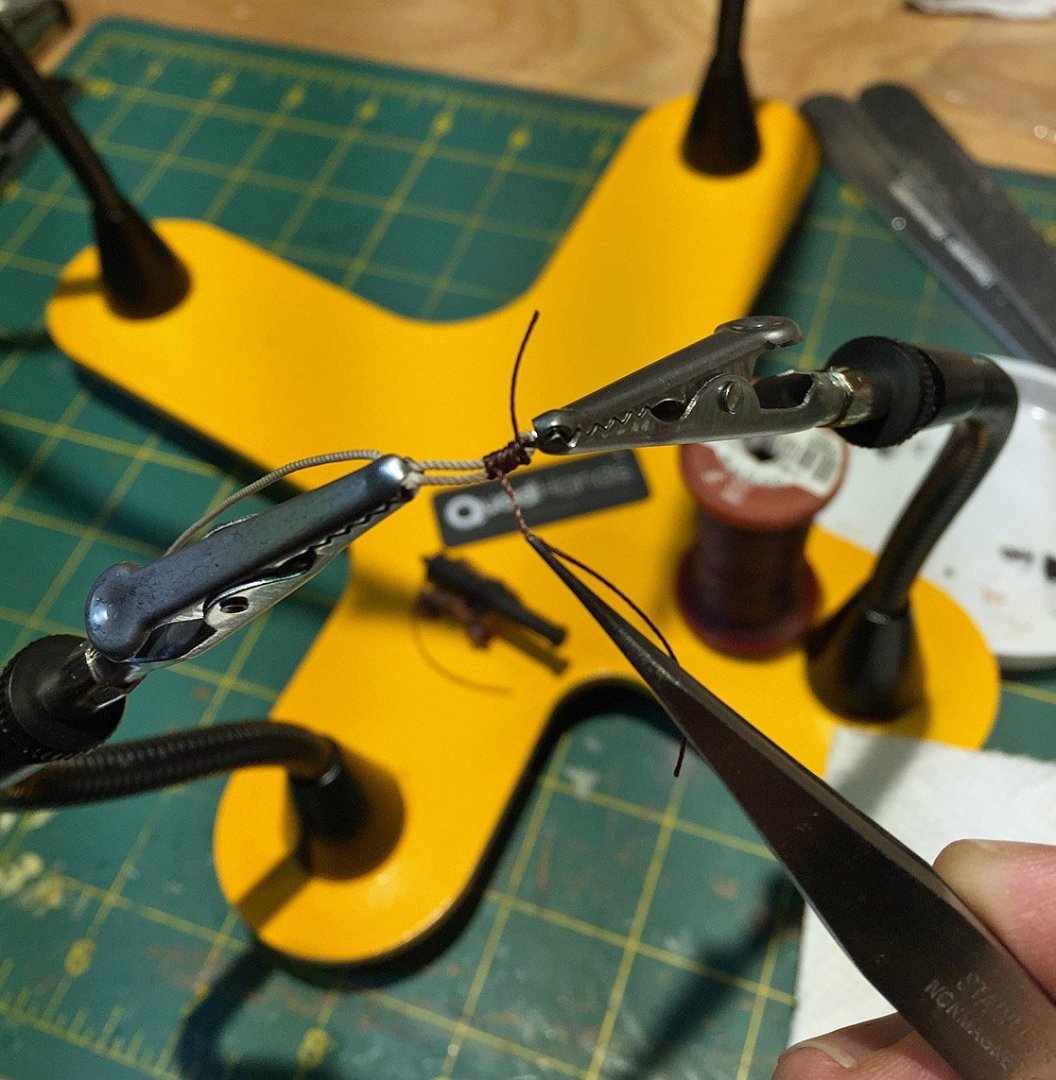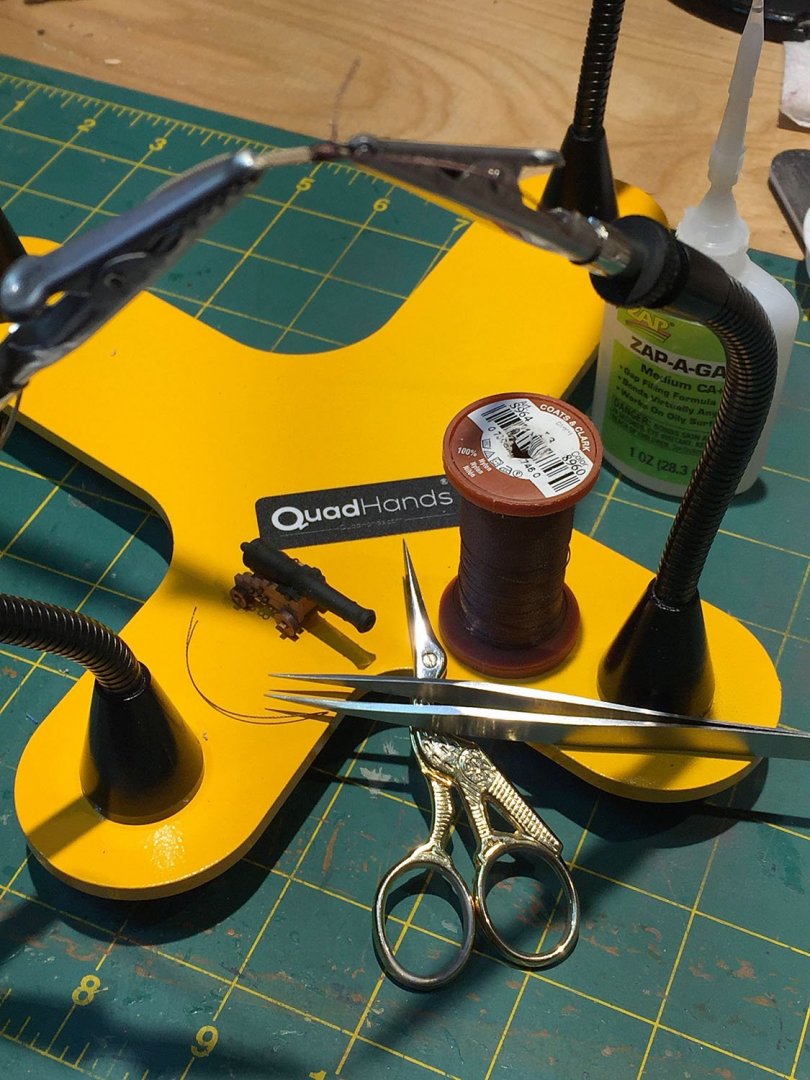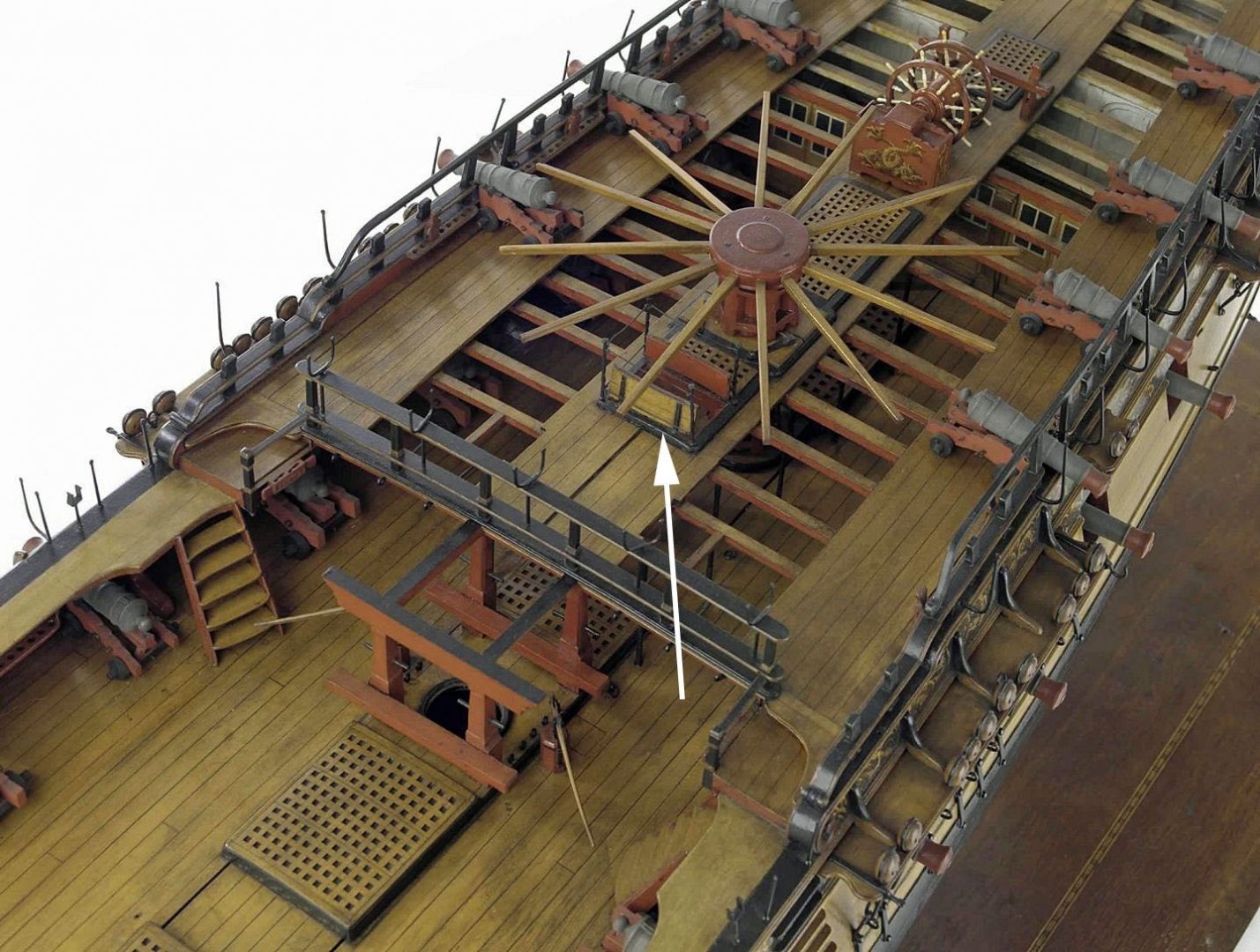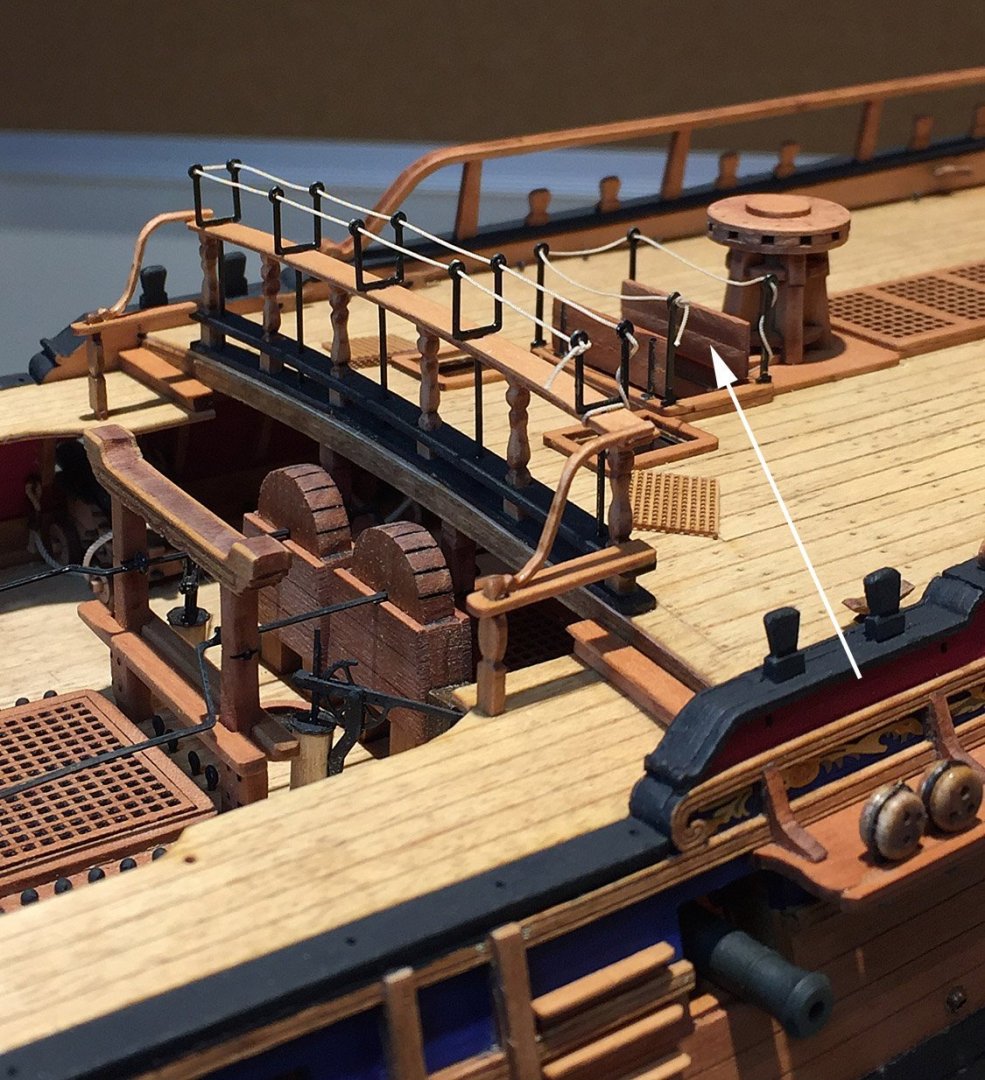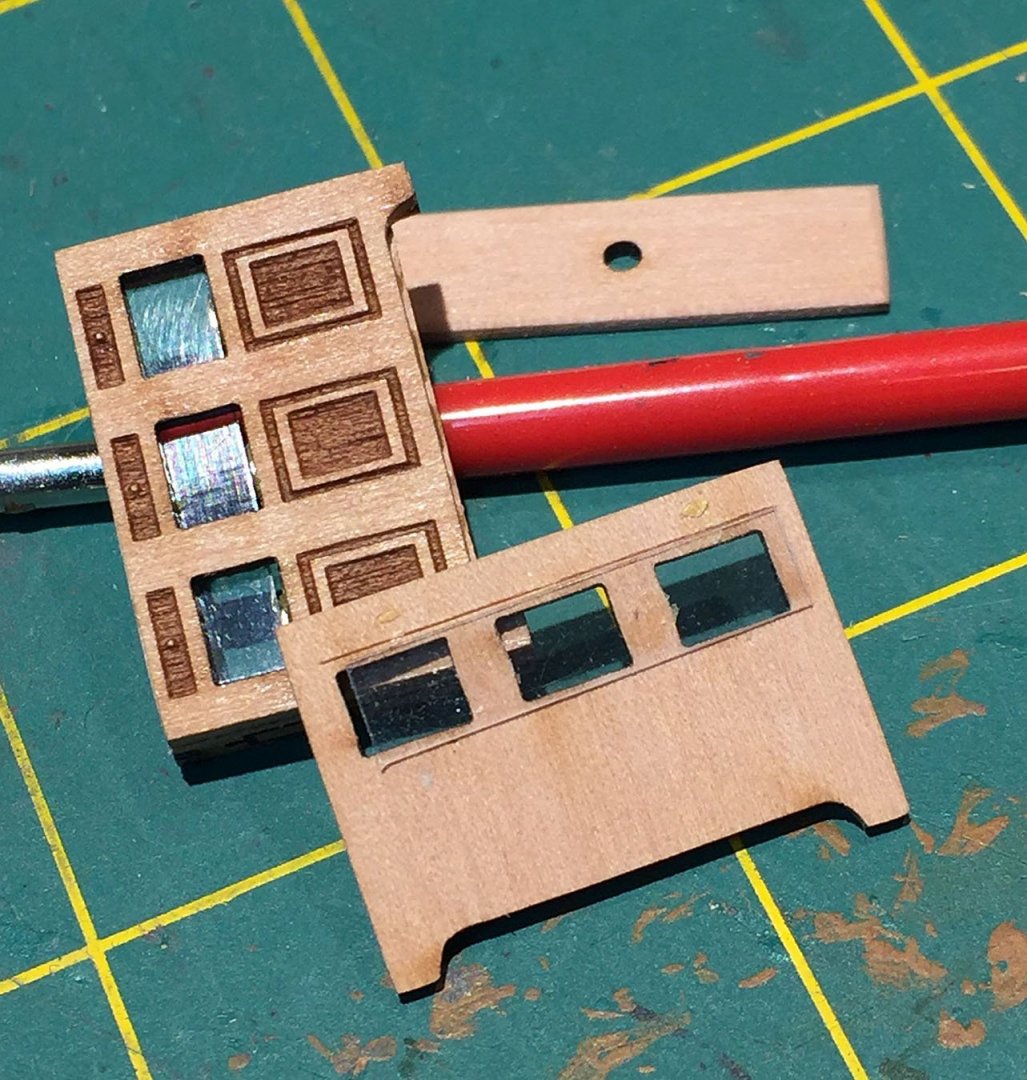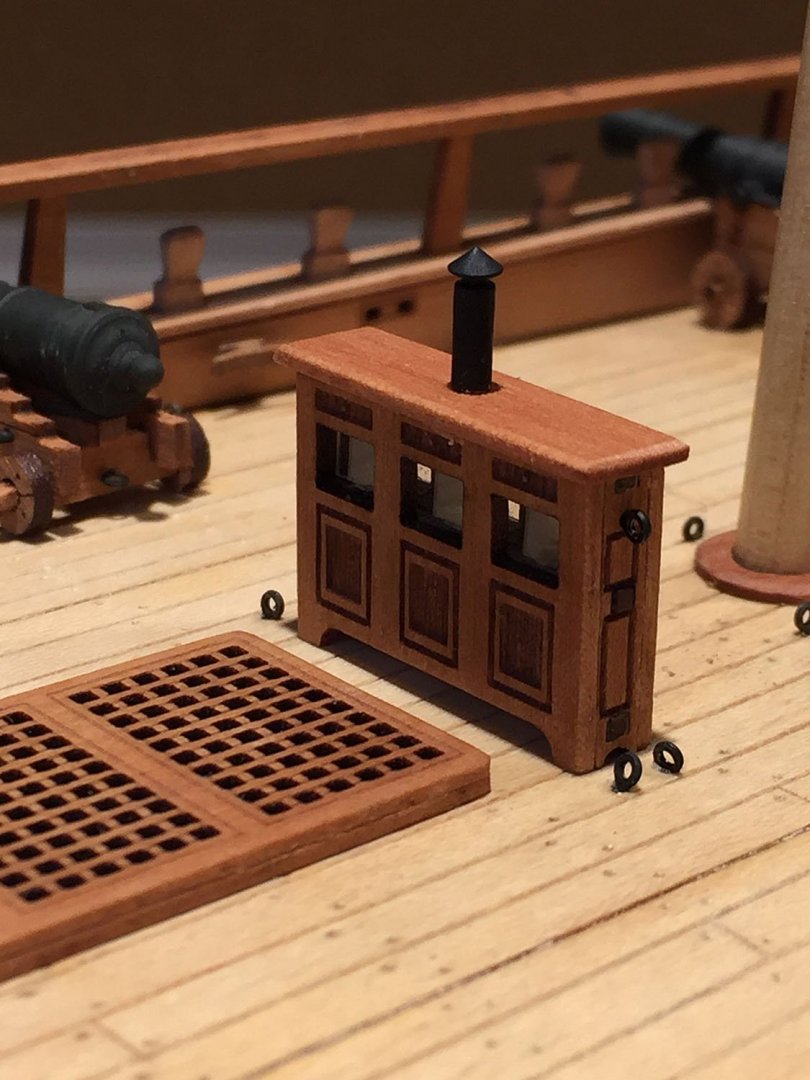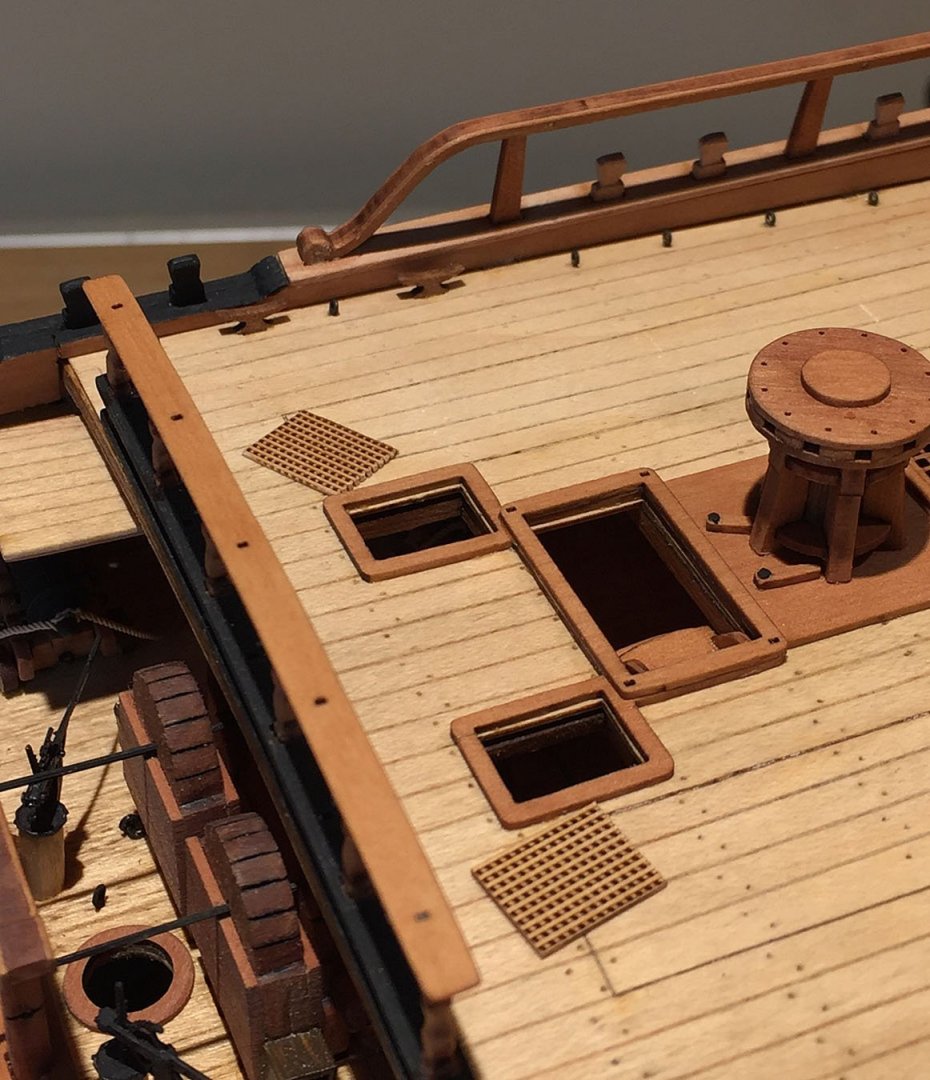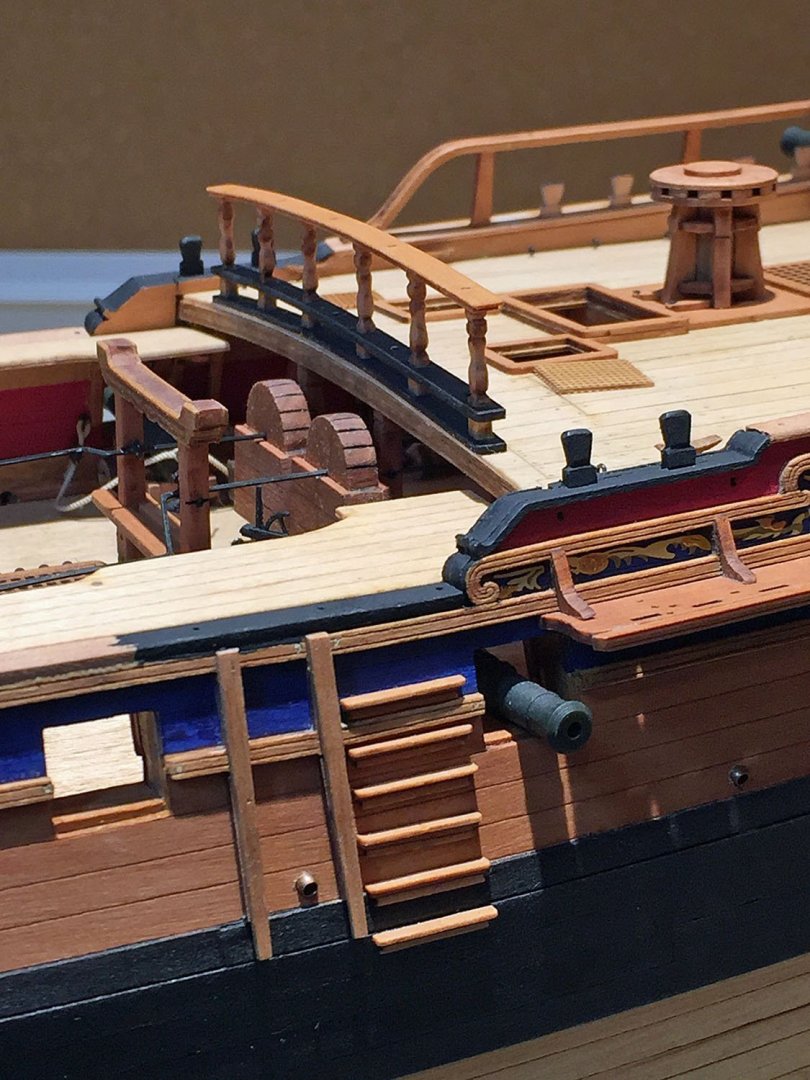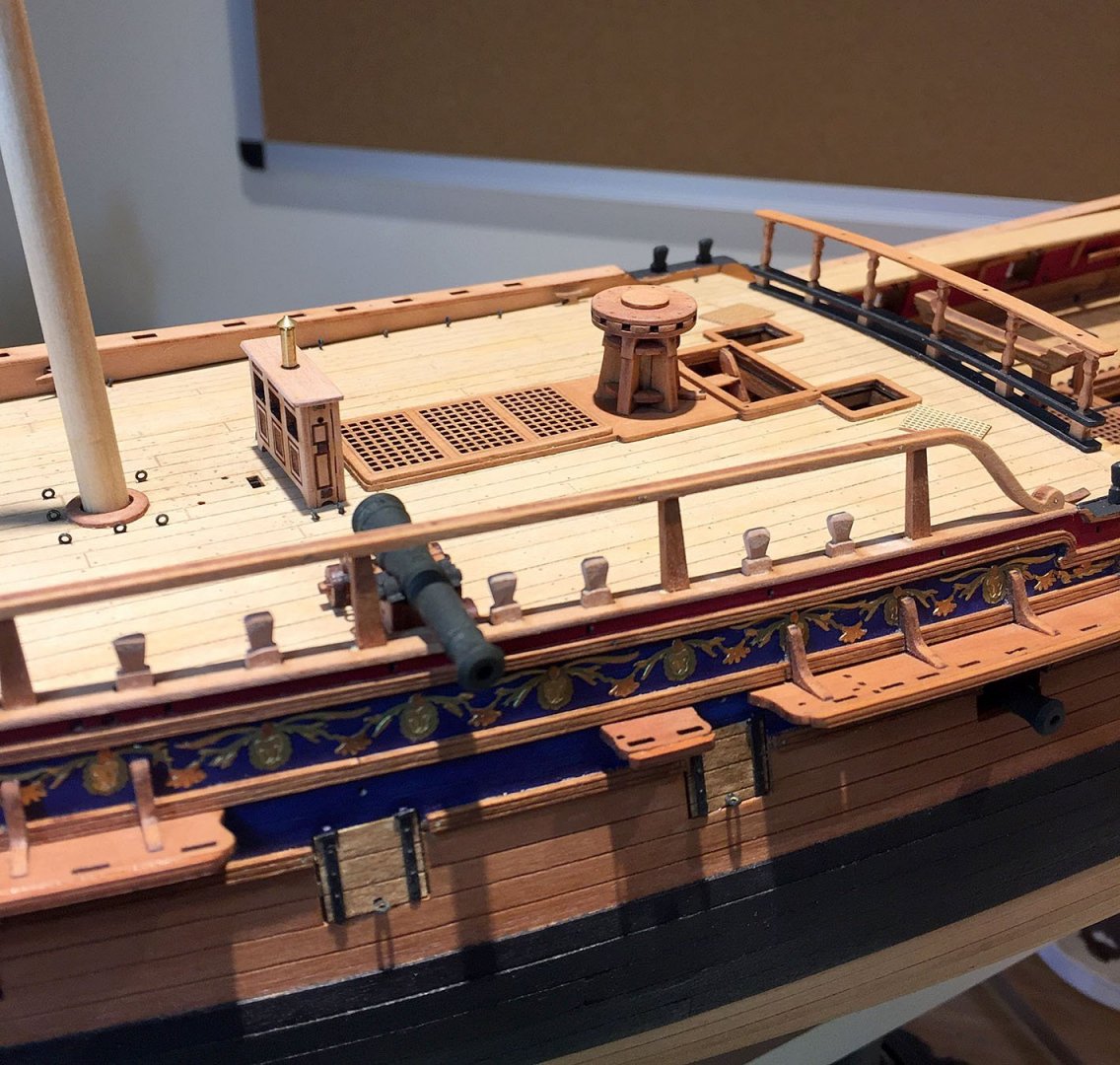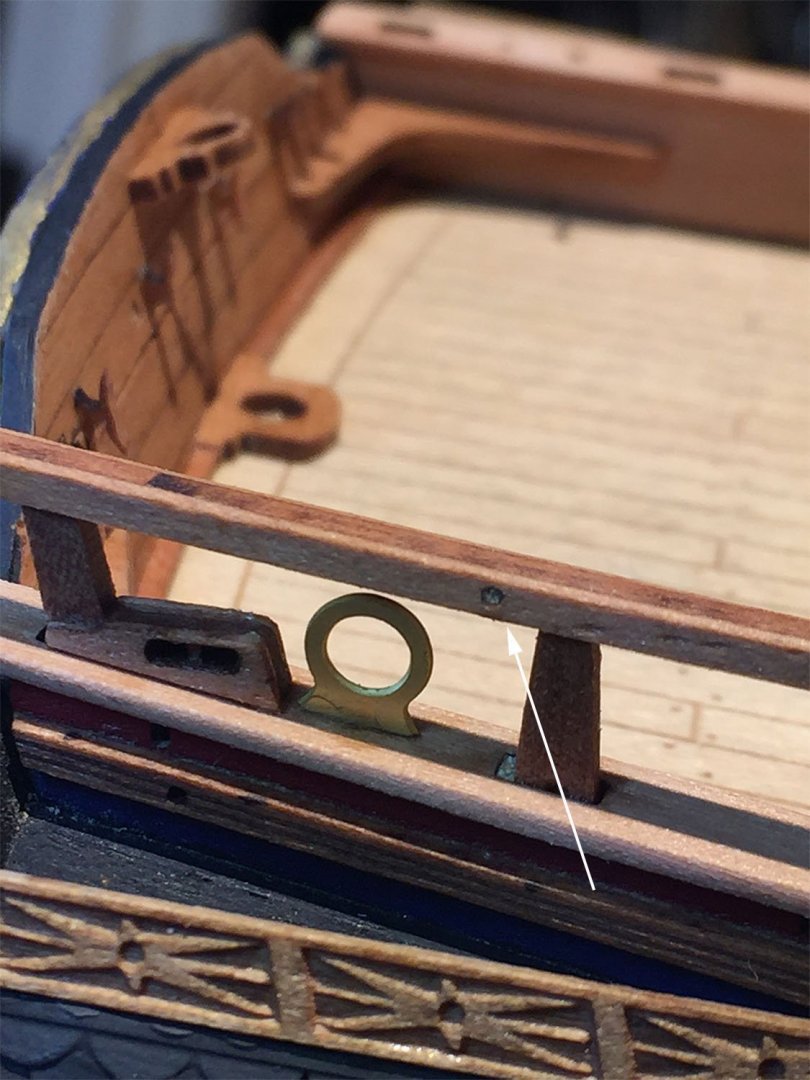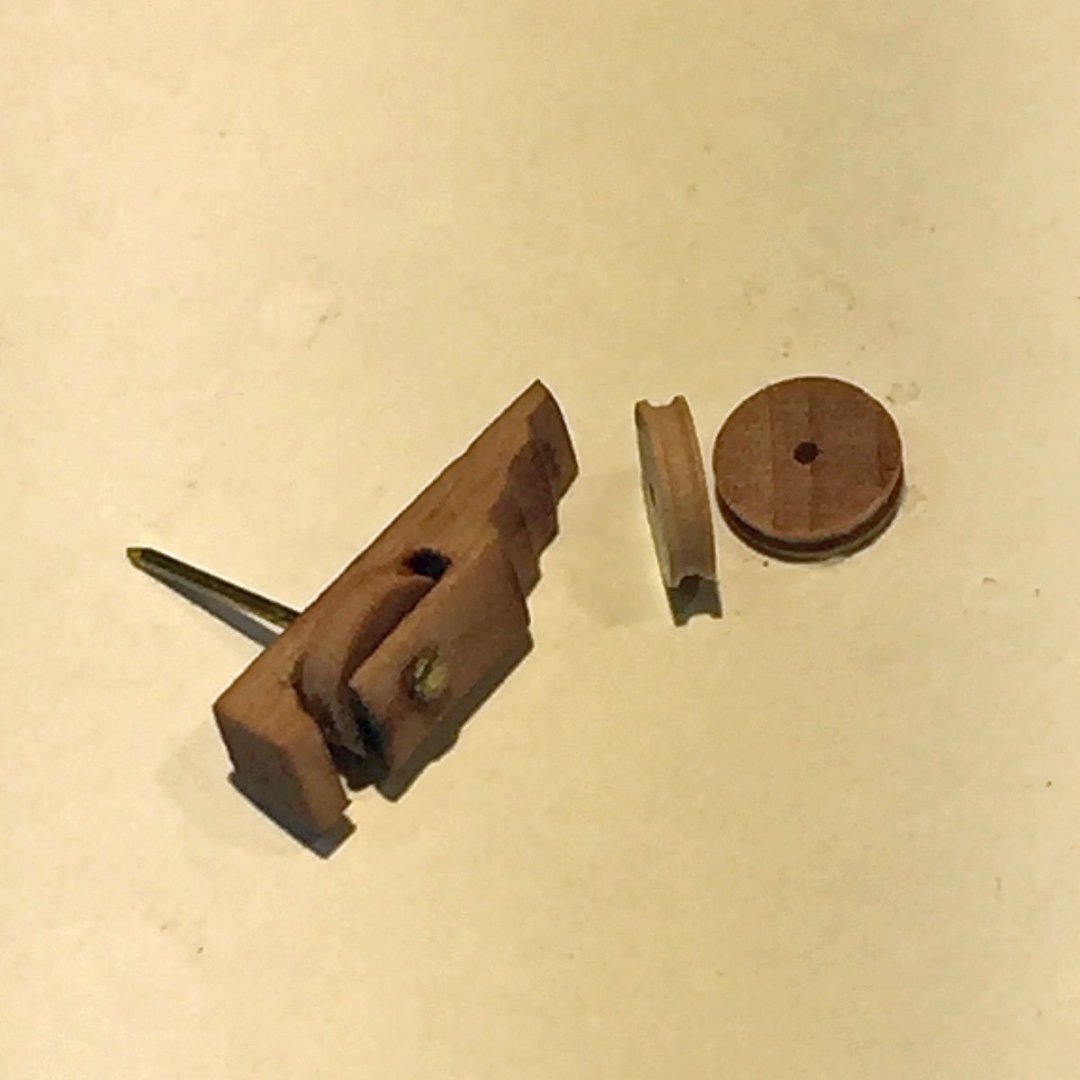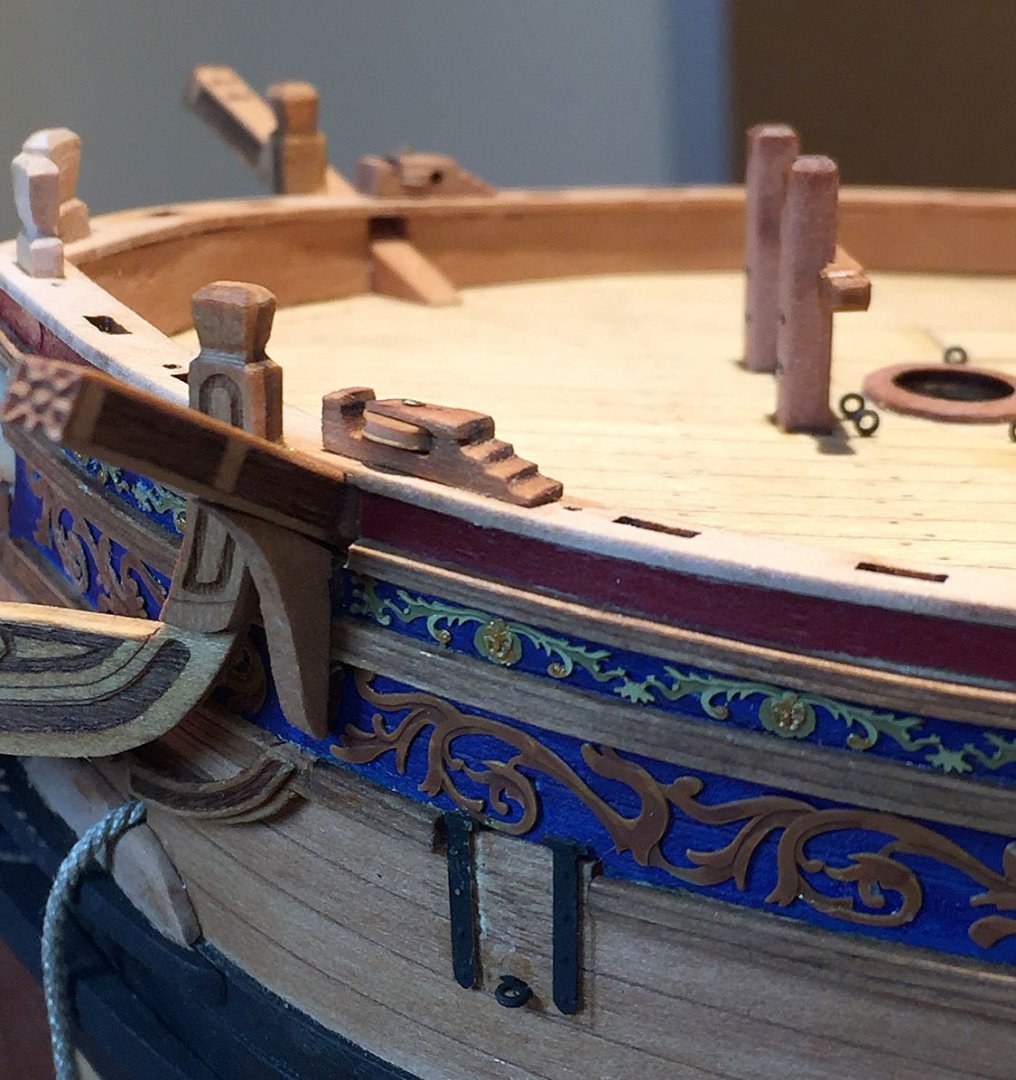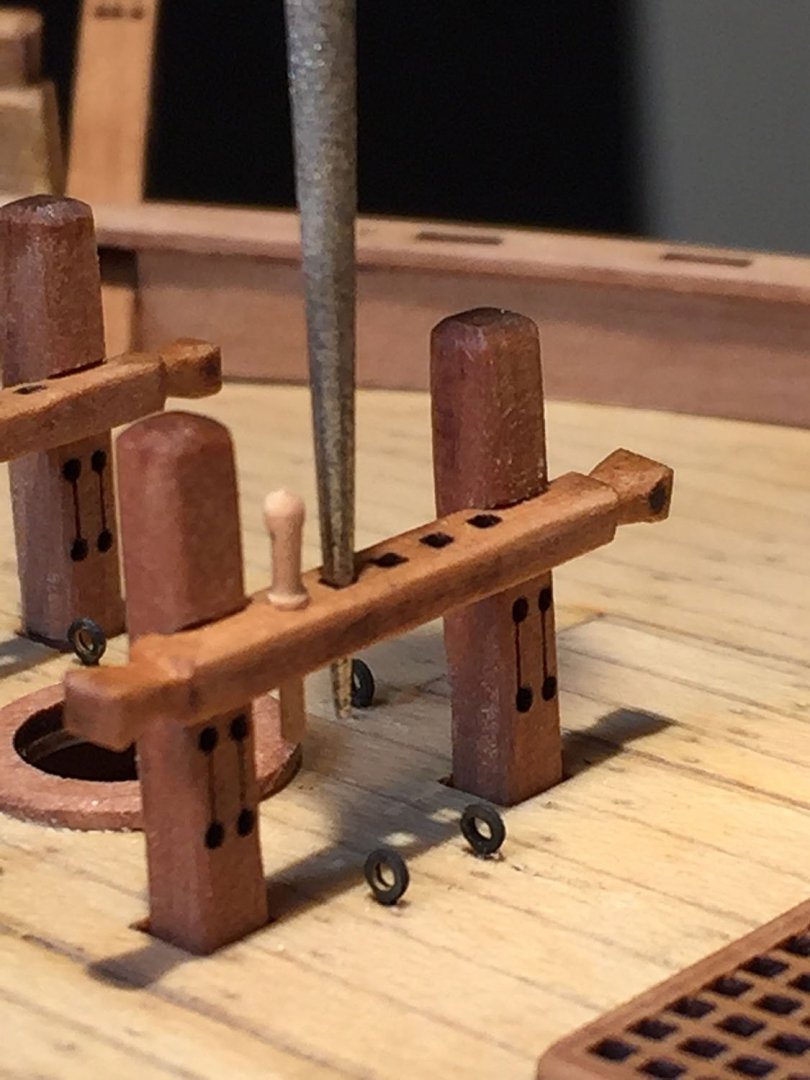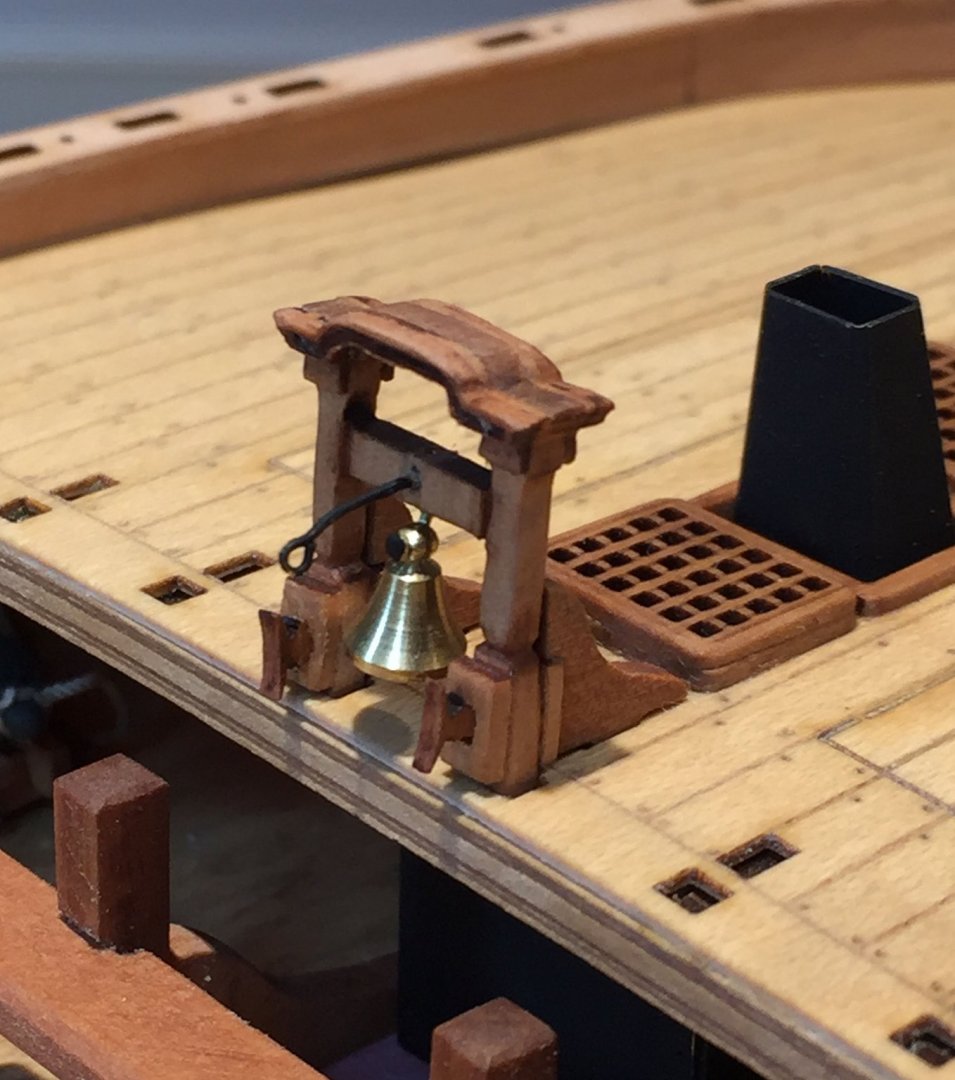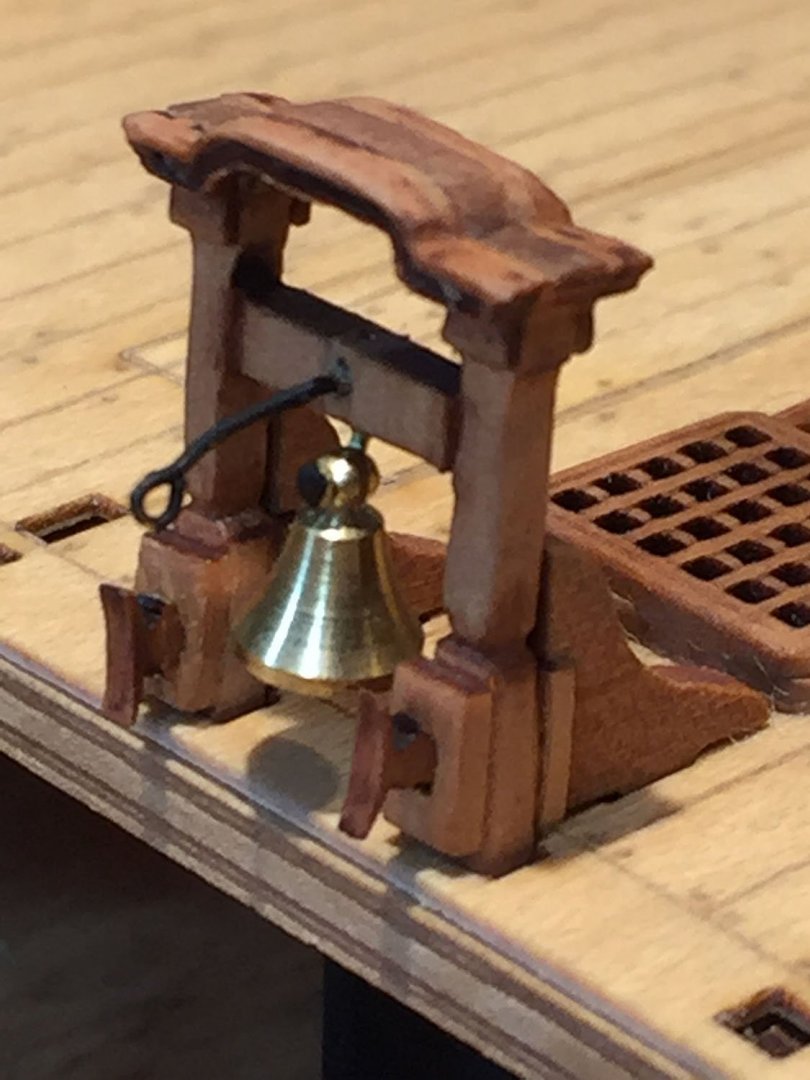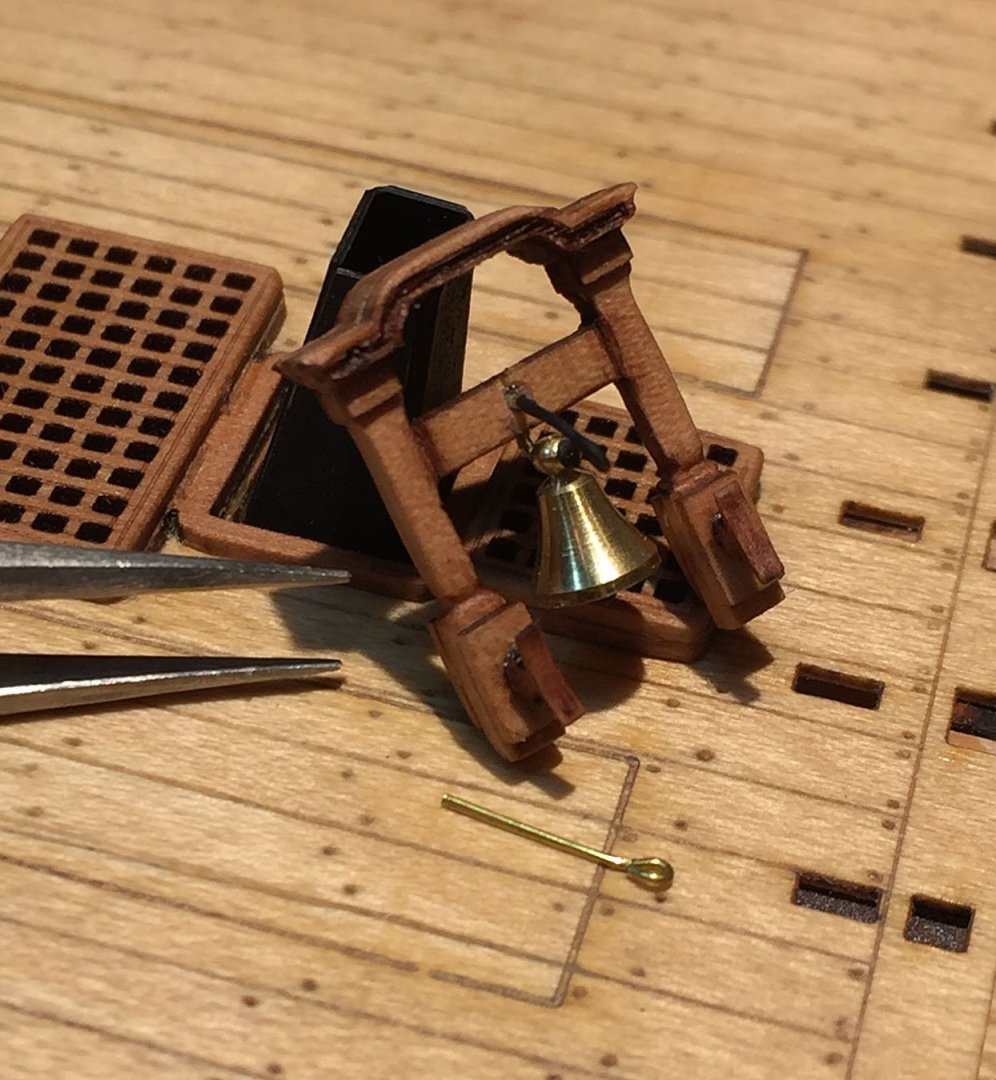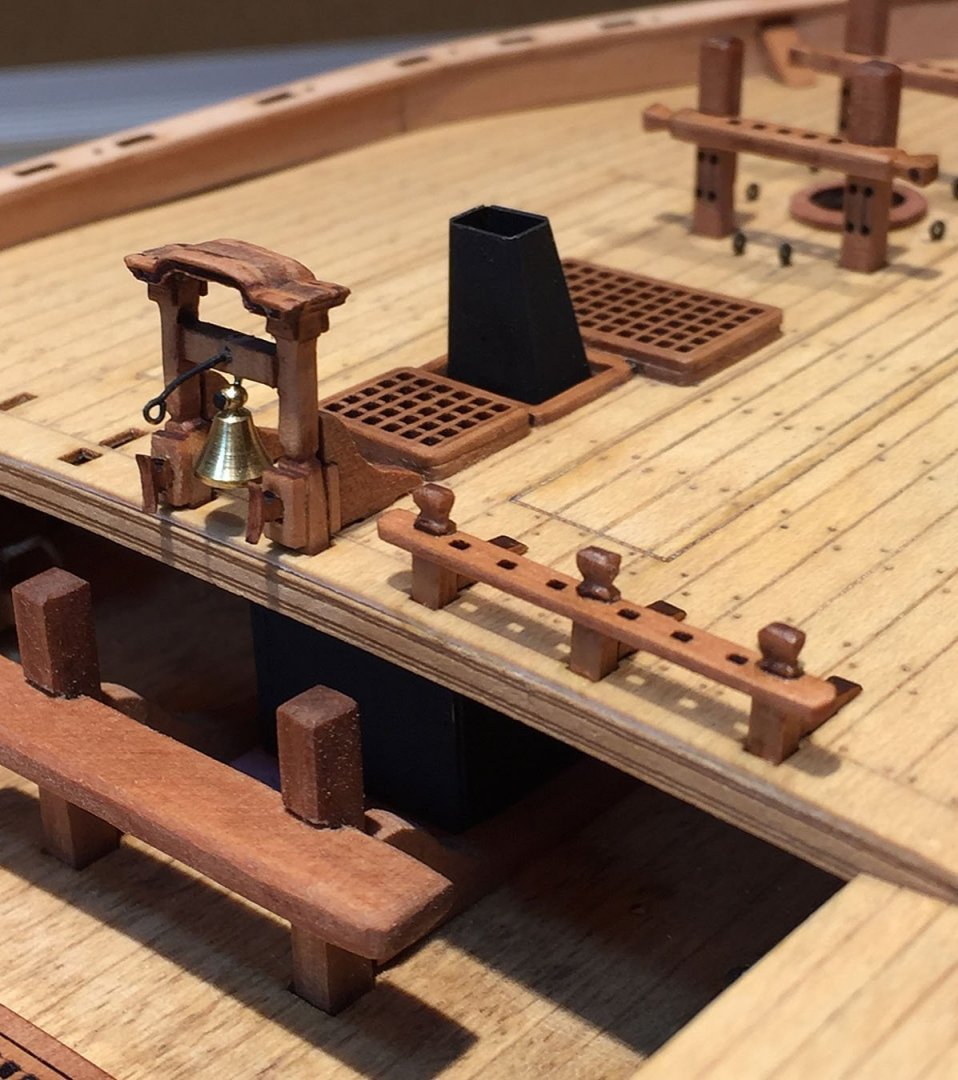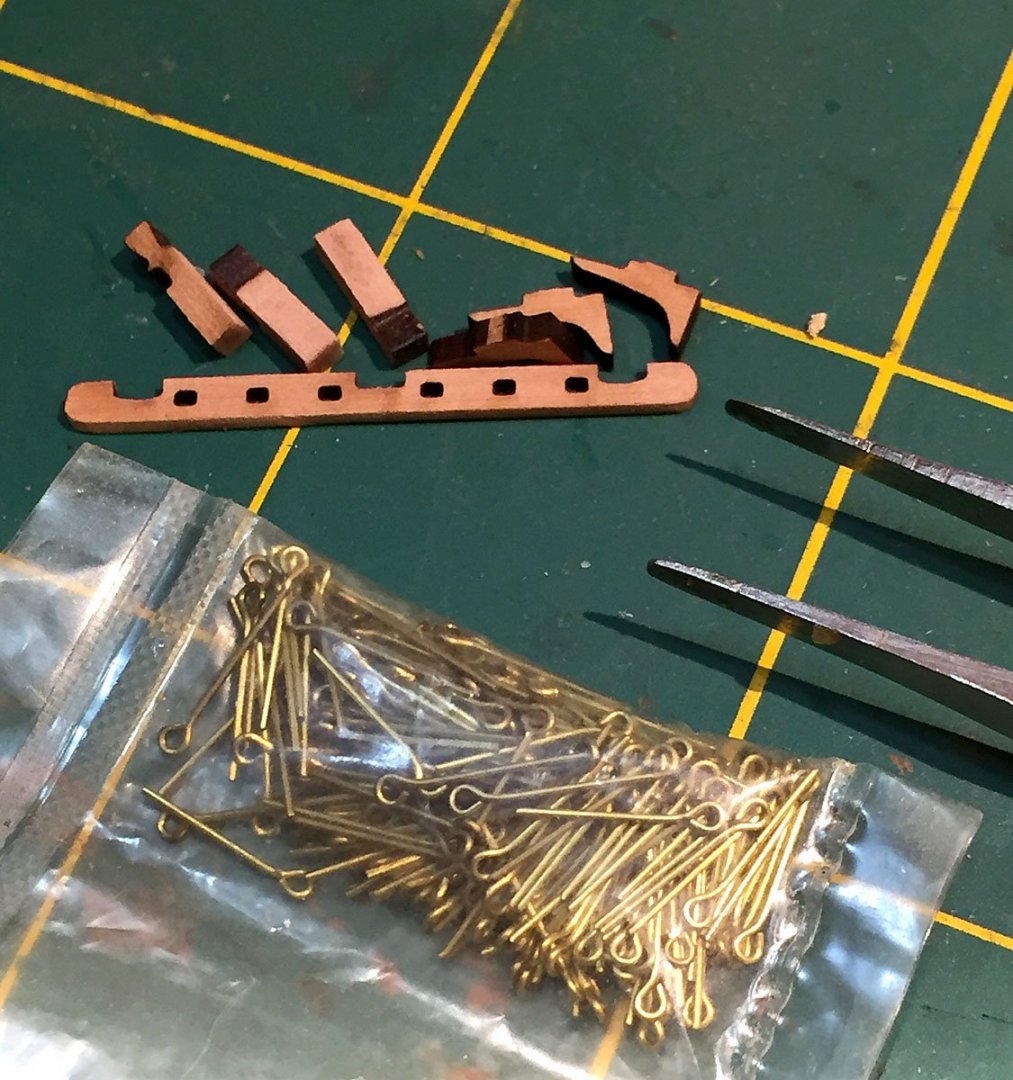-
Posts
1,554 -
Joined
-
Last visited
Content Type
Profiles
Forums
Gallery
Events
Everything posted by hollowneck
-
Thank you, B.E. Your build has given me excellent tips n' tricks: much appreciated. I'm one of those sailing ship era dudes who gets excited in anticipation of the next steps: rigging, set sails. Then...making the box and the H2O to set Camilla at sail. I am ever thankful my wife appreciates my need to display my model in a 24" X 48" diorama base to be placed somewhere in our house (as yet undetermined). For a few months, every sailing ship model is a beguiling Mistress, taking me out to sea, but she understands. I am a lucky man. Ron
- 542 replies
-
- Sphinx
- Vanguard Models
-
(and 3 more)
Tagged with:
-
Boomkins, Chains and a Full Deck… As Aretha sang: "Chain, chain , chain...chain o' " ...Port side chains completed. I may satin poly finish the deadeyes, haven't decided yet. My incomplete lower hull might confuse look-in modelers; HMS Camilla will be displayed in a waterline diorama. A boomkin, tapered and "bent" in its gentle curve; I used some scrap birch dowel for this piece. In very short lengths, the supplied walnut dowel didn't cooperate very well for me when it came to giving this prominent component a graceful arc. Process: after tapering and notching the end for the block rigging, I soaked the shaped dowel in hot water, devised a simple bending jig and used a heat gun to set the curve and then, when dry, some chestnut stain to finish it off (then the poly finish). The bowsprit is a temporary placeholder "stub." Gammoning this mast is going to be fun...🤯 The starboard q'deck carronades; as my wife says: "cute little buggers." Now mounted with their breeching ropes, ready for action! The ends of the ropes are simply tied-off and then looped over their respective timberheads. The smallest of the 12lb carronades in its carriage. The rope I used for it's breeching line and a small alligator clip (for scale). Like their larger siblings, I attached the served breech rope to the final assembly before I mounted it to its quarterdeck station. 12lb carronades on carriages: what a fun little mini-project - X4! There's a rigging eyebolt very close to the carriage wheel (and rope) I'll have to deal with before I get too far into Camilla's rigging. Worst case, I'll just move its position over a few mm's. A random pic just to show the different tiny swab brushes I use to paint and do final poly finishing. Each tip has its own utility in tight spots. These are available from MicroMark - or other hobby stores that do a lot of plastic kit accessory items. Invaluable - and for me- easier to use than holding small paintbrushes at awkward angles. Another cameo for Mr. 12lb Carronade (this one is mounted and roped on the larger carriage so it can aim over the elevated bulwarks position...) This early weapon incarnation still used a quoin to elevate the muzzle to a guessworked firing elevation; I'll bet this was fun to do in the heat of battle. Not. A few years later, some brilliant bloke figured out that an elevating screw mechanism was faster, safer and a lot easier to raise and lower the stubby and heavy muzzle-loading artifacts. This improvement became imperative for the Royal Navy as the carronade evolved to be a 24 lb - and in a few cases - a weapon that lobbed a 32 lb projectile. Work'in on a full house. A 52-card deck: caulking not required. A couple weeks ago I uploaded a photo of my last project (LeTigre) to Shutterfly (.com) just for the heck of it since they were pushing a special deal for $10.00 customized playing cards. I always take numerous photos of my models when they're completed since another past time is photography. I use my model photos for "coffee table books" as well as for other things, like large, framed decorative prints. The "photo books" I subsequently create and publish tell a background story on the ship, the history and other anecdotal references to my overall modeling project. I bit on the recent Shutterfly promo (heck, it's Christmas!). Impress your friends, intimidate your enemies. Bring them to the bridge or poker table; great for whist aficionados. That little rascal of a carronade keeps popping-up in different spots on my bench; I'd better tie him down soon... Happy Holidays Everyone. Let's hope that 2022 is the year that The Plague retreats for good and waves the white flag. Ron
- 542 replies
-
- Sphinx
- Vanguard Models
-
(and 3 more)
Tagged with:
-
The black & white checkered floor for the captain's cabin is printed, in scale, on a sheet of the Sphinx plans. Although not delineated in the build manual, I'm pretty certain the intention was to provide a printed and scissored "cut out" to simply affix over the laser-etched floor pattern on the one-piece gun deck, or as B.E. indicates, perhaps not use it at all. I haven't had to make this decision since I'm not building this kit as a quasi-Admiralty dockyard "reveal" model. Had I gone this direction, I would have stained the pear flooring slightly darker and chose - as B.E. also says: "…the understated look…" As many are witnessing on other HMS Sphinx logs, this kit includes many nice touches and encourages various levels of "scratching" enhancements. Really nice work, B.E. Ron
- 855 replies
-
- Sphinx
- Vanguard Models
-
(and 1 more)
Tagged with:
-
Indeed, it's also my experience that this kit is no "fit and glue job." As my own log of this excellent kit attests, there are several critical points in the build that have required a good forward look at the plans as well as the actual kit elements. Seeing various "bits" on the extensive P/E - and on some of the pear pattern sheets as well - ahead of when the build manual calls for them - has been a required exercise and a saving grace of sorts. Needless to say, other Build Logs, like this one, are revealing that this is no "slam dunk" of a kit (even for those of us who have long experience of creating models of this era)! I can also attest that Chris' innovative design has permitted a quicker (as well as more accurate) build for such a complex model. Cheers, Ron
- 855 replies
-
- Sphinx
- Vanguard Models
-
(and 1 more)
Tagged with:
-
Nice job. I'd love to get my hands on that wheel, steer her through some rough seas. Looking closely at your model, I was struck by the small size of the planking treenails; at this larger scale they appear to be quite accurately-sized. The reason for commenting about this aspect of your very nice model is that so many others, in their zeal to be accurate right down to the...uh...planking treenails, make them too large, and, if I may add another personal observation about this accuracy, much too pronounced: there are too many beautifully made ship models whose hulls and decks appear to have caught a serious case of the measles. I applaud that your representations of this over-worked detail appear to be "just right." Happy Holidays! Ron
-
More detailing and the addition of Quarterdeck Carronades. Four 12-pounder carronades awaiting their breeching ropes. The Vanguard carronades are cast resin to which you add small P/E parts for the cascabel breech loop, an elevation arm and a sight at the end of the muzzle. This last item - the tiny sight piece - is the smallest item I've yet to encounter in ship modeling! In the case of the smaller carriage assemblies, the straps to hold the carronades were made from 1.5mm wide black card stock which was considerably easier to fashion and mount than the small P/E pieces that didn't like the compound bending required to get them right. Two carriages are the smaller configuration (foreground) while the other two are similar to the larger long cannon carriages...because... ... the carronades at the aft most position needed the additional elevation to aim above the bulwark capping. This view shows all four in position, muzzles protruding between timberheads and clear of the subsequent shroud and backstay rigging. The breeching ropes (next on my mini-list), will have served loops that hook over the timberheads. Adding the carronades to the quarterdeck gave the 5th & 6th rates even more intimidation power during close encounters. The evolution of this technological and manufacturing armament refinement led to even more carronades being placed on the ships; the Foc'sle got two additional carronades and as the ships were modified or re-designed with additional built-up bulwarks (to protect the fighting gun crews), the calibre of the short-range weapons increased to as much as 24 lb capacities (a doubling). I decided to show HMS Camilla in this later era of adaptation to technology; as the British Navy entered into even greater conflict with France at the end of the century, the new weapons (and superior expertise of the sailors), gave the entire English navy decided tactical advantages. Swabbing the channels...with a Wipe-On polyurethane, except it isn't wiped-on. I use compact swabs for detailing the components I want to have a polyurethane finish (Satin). These come in mulitple packs from Tamiya. This is a final step before attaching the deadeye assemblies on all the channels. Another view of applying the satin polyurethane to the exposed pear pieces. I choose this finish, in part, to emulate the old-school finishing that typically used either varnish or shellac on models, both natural wood finishing materials. Don't forget to mount eyebolts to the channels before you rig the deadeyes and chains. The same applies to the stunsail boom hardware shown here. Carronades in-place, some deadeyes mounted. The majority of the model's pear wood components have been carefully coated with a satin finish and left to dry for at least 24 hours before proceeding with any additional handling (thinking the chains and deadeyes). 12 lb carronades on the quarterdeck. These stubby cannons could lob salvos of various metal bits at an enemy ship in close range. This subsequently became known as "schrapnel." Certainly, the deadly shards of metal could kill or wound an enemy's sailors but the prevailing tactic was to aim the beefy, short-range cannon at rigging and sails. If the enemy ship's propulsion system became compromised, it usually led to their subsequent capture - a priority for many a captain and his crew - and, in many instances, prize money for all. My preferred poly finish. Oil-based, it takes a while to fully dry, especially in cold months. The cotton swabs from Tamiya shown here for scale; the swabs are very narrow and allow one to apply the synthetic finish in tight spots. Once dry, the poly finish is very tough; to my eye it also appears to deepen the underlying colors of the surfaces to which it is applied - a benefit in addition to protecting the hardwoods from moisture, ultraviolet light - the ravages of time... Don't forget to attach the various eyebolts and the stunsail boom stirrups and brackets to the fore and main channels before mounting the deadeyes and chains. A handful of midship hammock cranes have been rigged with their ropes. In addition to the exposed natural pear woods, I've also applied the satin poly finish to the wales. I decided to add even a little more pizzazz to my über-detailed belfry: a copper sheath on the fancy capping piece. I added a little darkening chemical to "age" it. I like the look of the belfry's contrasting brass bell. The Falkonet 9mm pear belaying pins are in-place and stained. The foc'sle safety rope stanchions have been rigged. I'll note once again that these 300- 500% close-up photo magnifications have the effect of raising one's game. When I download the photos from my iPhone to my computer, I'll see all kinds of things my normal vision doesn't catch. I'm using the "zooming" software in my phone for the enlargements; this is not ideal since it lowers the resolution, however the benefit is very effective for evaluating where I need touch-ups - and in a worst case, a do-over... I've chosen to make Camilla's deadeyes black; to accomplish this I use Fiebing's leather dye in their black solution; the company makes a number of colors. The dye penetrates tight hardwood grains, is permanent and dries flat. Get some on your fingers and it will be there for a month or two (just kidding, but it does GO DEEP)! Before dipping the deadeyes into the dye, I gently sanded-off most of the finish on the kit's supplied deadeyes (large and small) with a small nail file. This is quite fiddly and time-consuming indeed, but worth it to me. If the shiny finish on the deadeyes isn't removed, the dye only gets into the holes and the routed exterior rope channel effectively, which isn't where I want it. A mild dilemma: the arrows point to a selection of rope stanchions on the quarterdeck bulwarks; I'm not certain these were used for hammock cranes in addition to being safety lines, but possibly. The position of these tall metal bars appears to interfere with the shroud line rigging for the mainmast. I've mounted them temporarily and I'll soon find out if they interfere. I like the look of the black deadeyes matching the black bulwark capping, the sharp contrast with the pear channels and other pear bits. I don't know how historically accurate this is; however, I do know that I've seen dozens of Royal Navy models of the era with black deadeyes! I await my black eye from someone here who can offer more detail on this bit of arcana! Ron
- 542 replies
-
- Sphinx
- Vanguard Models
-
(and 3 more)
Tagged with:
-
I like it! The font looks spot-on: an excellent, historically-appropriate choice. A suggestion: when you come to finalizing the artwork take a look at (slightly) tighter letter-spacing (also called kerning). This will also allow you to enlarge the characters by approximately 1, perhaps 2 points. Personally, in conjunction with all the embellishments you have planned, I like the yellow/ochre for her badge; however, I'm not certain that this color choice was used in the era. I'm sure there are members here who have some knowledge of this historical detail. Your model is coming along very nicely. Kudos. Ron
- 855 replies
-
- Sphinx
- Vanguard Models
-
(and 1 more)
Tagged with:
-
You may want to ask - or PM - "druxey" about the most likely font that would have been used for a ship of this era. Great idea to include the lower counter painting details ala' Passaro; this will certainly enhance your very nice build. Ron
- 855 replies
-
- Sphinx
- Vanguard Models
-
(and 1 more)
Tagged with:
-
A number of finishing details in this update. Boomkins shaped and mounted. They look huge and out-of-scale here. However, they are tapered and have a slight curvature per normal. I've started serious considerations for Camilla's presentation in the water and what the sea conditions (and colors) will look like. If I decide she's headed into choppy waters and few big swells (the pervasive image throughout my build), I may need to add a few more planks to her bow (not the stern). I envision her cutwater smashing into a large wave, her stern escaping a deep trough and her sails showing a serious starboard list. A set of belaying pins in the forward foc'sle bitts, ready to go! These are the turned pear ones from Russia. Click on MSW's homepage link of vendors for "CraftySailor" for the belaying pins as well as lots of other really nice kits n' bits. No business affiliation here, but definitely a strong endorsement! The dual stern lanterns are superbly-designed, 3D-printed assemblies, the detail quite remarkable; for example, if one looks closely under the cap, there are tiny holes for the air and heat to escape! In addition, they are glazed with a single-piece, laser-etched clear acrylic that is fitted into the interior of the main, single-piece body. This requires a little trimming to fit properly but nothing too drastic or difficult to accomplish. The cap fits perfectly to the body of the lantern. There are lots of options on colors for these two lanterns; I chose to stay with basic black with a touch of gold. Lastly, they mount with a piece of thin brass rod supplied in the kit and fit into the holes that were previously drilled - from the interior transom - from an earlier build stage. I have pliers with stepped, graduated round sections that can precisely bend brass wire into smooth, curving shapes. The ensign pole is also a temporary placeholder. This view doesn't show the acetate glazing mounted inside the stern lights, but it's there! Camilla's name is yet to be placed on the upper transom; this will be added as soon as I decide what color to paint the board where the letters will be added. Those building this kit know that the "SPHINX" name is etched into the pear transom pattern and is a guide for subsequent mounting of the P/E letters. Rather than replace this tricky piece with a scratched one, I decided to simply mount an appropriately-sized, thin section of .6mm pear (lots available from a kit sheet) over the etched name with an added signboard. I'm testing the look and fit of two items here: the addition of a spare topmast to be made at the same time as the one that will be fastened to the lower mainmast. The dowel here is only a placeholder, but cut to the right length of a finished mast. I've placed the 24' launch's pear keel piece from the kit on top of three beams that fit across the width of the mid deck. I'll only need three beams here to carry the spare mast (the kit offers four) and launch when it's completed. The launch will be flipped "belly-up" and lashed to the beams, with no rigging or "boat bits" evident (see next photo). This decision means that I'll only be building one ship's boat purposefully. When completed and underway in the English Channel, my depiction of HMS Camilla places her in an action setting; she has left port on a war footing, with only one boat aboard, and a Captain itching to secure a French prize for himself and his loyal crew... Here is a placeholder hull for Camilla's only boat. I'm not rigging the hammock cranes until much later in the rigging stage. They'll carry ropes as well as netting. By displaying only one boat (and not the three provided), there is lots of visual space so that the details of this exceptional kit will be clearly visible, even post-rigging. Another gull's eye view of the midships arrangement of the spare mast and launch. A spare topmast was more important than another boat. I'm guessing a topmast weighed about the same as a boat. I've put placeholder masts in position just for the fun of it (including the bowsprit). There are just a small handful of items left to do before masting and yards - like all the chains and deadeyes! Oh yeah, rudder chains and ropes, the balance of the tompions...and... as soon as the four Vanguard carronade kits arrive, they'll be assembled and mounted on her quarterdeck, the proper positions pre-determined. Camilla has temporarily sculled into my dining room so the Admiral can help me decide where she is going to go after she departs her building slip in the basement...🤪 Ron
- 542 replies
-
- Sphinx
- Vanguard Models
-
(and 3 more)
Tagged with:
-
Igor, A very nice build, indeed. You are a champion of Master Korabel's models. You also had fun taking these photos! Kool closeups and angles. They are excellent and display your skills nicely. Do you know if the silkspan you used for your flag is the lightest weight material? Sig make three weights if I recall correctly. The tape on the edges of the A4 didn't jam the printer? Ron
- 30 replies
-
- master korabel
- avos
-
(and 1 more)
Tagged with:
-
I knew you had the answers! Spanshackle in the center - check; rigged fish davit - check; anchor lining present-check. Thanks. I'm presuming that the word "fish" is a verb and therefore attached to "davit" because one had to "fish out" the anchor from the sea bottom and had little to do with feeding the crew...🤣 The photo appears to be your HMS Resolution, correct? Ron
- 542 replies
-
- Sphinx
- Vanguard Models
-
(and 3 more)
Tagged with:
-
Although it appears the davit is too far extended, I like that the Lowestoft model shows large blocks and tackle affixed to the end and back to the channel, presumably to raise an anchor. If a fish davit was used, would the hauling rope thus be affixed to a capstan? And, would there still be a need for an anchor lining? It seems the fish davit/spanshackle combo disappeared by the late 1700's, yes? ...finally, was a fish davit used for any other purpose (e.g. lifting a boat onto the deck or loading ship's stores)? I'll bet you know the answers to this sailor's burning questions! Ron
- 542 replies
-
- Sphinx
- Vanguard Models
-
(and 3 more)
Tagged with:
-
Your insights are always valuable and valued! That makes good sense, Druxey; just follow the Laws of Physics. The fish davit is not only lengthy, it it bulky and had to be a really heavy lift to put into service. The ropes along its midsection for sailors to manhandle* also makes perfect sense. My Granado model's fish davit is lashed down across the foc'sle. Knowing how bomb vessels were deployed, having a handy fish davit makes perfect sense too. Cheers, Ron *manhandle. I love this word, almost as much as spanshackle.
- 542 replies
-
- Sphinx
- Vanguard Models
-
(and 3 more)
Tagged with:
-
Ai! - Exactement, charaid. You're the winner of my Dalwhinnie dram. I'd be pleased to down that Tallister of Tennant's on my next visit to Falkirk (after dropping in to the Tun Mash in Forres). You won't be surprised to know that I also built the Caldercraft Granado a few builds (and years) back and - discovered the spanshackle hardware artifact - and I subsequently looked it up in Lee's. Sláinte! Ron
- 542 replies
-
- Sphinx
- Vanguard Models
-
(and 3 more)
Tagged with:
-
Thank you, Chris. I am really glad that I can make this excellent kit's designer pleased. I can't wait to take some hi-res, properly lit pics of this beauty. I can see the finish line on completing the hull and it's truly been a fun project right from Page 1. I am now looking forward to getting started on her masting and rigging. I plan to make some modifications with materials for this part of the build; I'll clearly note where I've substituted (initially, for masting/yards). I always use square section sticks - either pear, box or a combo of both, so I'll put the kit's walnut dowel in a wood stash. I've done a little research on how stunsails were deployed on these 5th and 6th rates. It seems that some ships used stunsail booms (the flip-out yards mounted to the channels), but some mounted these helper sails "loose-footed" - the bottom of the stunsail held taut with a single rope lashed to a triangular arrangement at the foot. Apparently, there were advantages to both methods. I'm mentioning this now as I haven't decided whether or not to mount the kit's provided stunsail booms to their channels since I intend to make and mount these sails in addition to the vessel's normal complement, a first for me. I love a new challenge - obviously! Hey Glenn. Good eye...but...actually, Camilla can turn to port and starboard. In both of my photos the opposing end of the steering rope is hidden behind the wheel's stanchion(s). It really does descend down and right through the first Lieutenant's cabin. I know this because he asked me if I knew what a "spanshackle" was. (I'm holding-off on giving a definition for a few days; I'm curious how many builders of this era have this bit of arcane nautical engineering knowledge. Hint: the device was a critical piece of gear that helped to weigh anchor.) NO GOOGLING (please)....🤨 Ron
- 542 replies
-
- Sphinx
- Vanguard Models
-
(and 3 more)
Tagged with:
-
Mike, Thanks for the shout-out! I hope to get to her masts before the Season wipes out my shop time (7 children, 13 g'kids.) Happy Holidays (did I say this already?) Ron
- 542 replies
-
- Sphinx
- Vanguard Models
-
(and 3 more)
Tagged with:
-
In between the Holiday Madness...more detail work...a few things left, then off to masts & yards. Love this rope! The correct scale, the correct color...but it unravels into three wild-hair strands if one isn't careful! Russian rope (Falkonet),da! The rope feeds through the deck and is termed "steering rope" as it guides the rudder via a series of below decks pulleys. I kept the outer brass circular P/E "ring" and made the main P/E component of the Big Wheel in "wood." I added three layers of burnt umber acrylic paint to build up the handles and spokes (slightly). Being P/E, these are all flat. I also did a paint "fill-in" on the P/E ring: after painting (and drying), you scrape-off the paint with a knife or sanding file (my preferred technique). This leaves the tiny brass heads and the shiny rings intact with the paint only filling the lower recess all around. The binnacle, mounted. Temp mast in-place for scale. A gull's eye view of midships. A nice clean deck, unlike the hood of my car. This is a three-piece, layered detail. Not clear in the manual, but spotted in the lasered pear sheets. This is the fish davit crutch. I kept looking for the spanshackle* P/E, but there aren't any. Will I scratch one? probably not since I'd be then semi-obligated to add the actual lengthy davit that literally spans across the entire foc'sle deck!... *this is a test: what is this and what does it do? Correct answers to what this is will get a free shot of 18yo Inverness Scotch (neat or rocks) at my house this Holiday Season... Breastrail and gangway details close-up; the rope is much brighter here due to intense overhead lighting*. The rope is the same tawny hemp color seen in previous detail photos in my log. Yummy stuff, this rope. * I use three direct overhead light sources which helps immensely, especially when I'm evaluating critical color painting and then shooting decent detail photos. A view that says:" I'm nearly done with the hull!" Hammock cranes come next after installation of the chains, which I always leave for much later in my builds. Rigging (reeving) tools: I use brown upholstery thread for reeving. In this photo I'm tying-off the ends of the cannon breeching lines to their eyebolts. Tweezers mandatory. Quadhands holder is excellent for this although I only needed two of the four flexible tentacles to get the job done. I use CA in infitessimally small drops to secure the lines...and a secret weapon for nearly all rigging tasks: my Gingher embroidery scissors. My inspiration for adding the companionway doors to Camilla; this is a pic of an NMM "Admiralty Board" model of a 5th-rate that is nearly identical to the Vanguard's Sphinx kit of the same era. The double wheel is kool and I thought about scratching this too. The Sphinx (& Camilla) didn't carry normal Ferguson long cannon on their q'decks normally - but, rather the shorter 12lb carronades (in trucks, not swivels) which I'll add as soon as Vanguard can send them. Midships closeup; gangway rails, steps and companionway doors (scratch added). Borrowed (unused) P/E hinges from an earlier part of the kit build and made simple 3mm pear strips. See previous museum photo. Ron
- 542 replies
-
- Sphinx
- Vanguard Models
-
(and 3 more)
Tagged with:
-
Thank you, gentlemen. Indeed, this is the "fun part!" Ron
- 542 replies
-
- Sphinx
- Vanguard Models
-
(and 3 more)
Tagged with:
-
Well done, Sir. I like how you've tackled the one-piece wale patterns and solved the dilemma at the stern. After scratch-planking my wales I moved the six scuppers up from the wale to just above the black strake. The "angle of drainage" from the waterways still works. Perhaps Chris can 3D print Lord Cochrane sitting on a seat of ease for you! We need to be able to view him thru the gallery lights though... Ron
- 855 replies
-
- Sphinx
- Vanguard Models
-
(and 1 more)
Tagged with:
-
Progress...more detailing. Upgrading the binnacle. Fashioning and finishing the fife rail. Snatch block with sheave. Bitts and belaying pins. Gratings for the q'deck "fix." The kit's binnacle is laser-etched pear and it assembles nicely- however- it was missing its windows! The brisk and unrelenting wind on the weatherdeck would have constantly blown out the illumination source and made it difficult for the helmsman to see what heading the ship was on! I remedied the situation with a couple small pieces of clear acetate before I buttoned-up the assembly. Voila! Kool brass chimney (painted flat black) on this little top deck eye candy. Stained with Natural Minwax only. Needs some rope to keep it from toppling over; on my punch list for later this week... a detail that can't been seen in this photo is the thin, internal P/E brass piece that depicts dual compasses and a place for an oil lamp in the center. I know it's there, a "sweet touch." BTW: the cannon on this deck will be early 12 pounder carronades on "trucks" (essentially a version of long cannon carriages). I am looking at where the four carronades will be positioned along the slender bulwarks and exposed timberheads and fife rail stanchions. 6th-rate (and 5th rate) "post ships" quickly adopted carronades on their quarterdecks (and later the foc'sle). It didn't take long for the Navy Board to discover that these ships needed to have "built-up" bulwarks to protect the crews and come up with a new method for mounting the powerful "smashers" to the bulwarks. The unique "sliding carriage" was invented specifically for these large-muzzled, close-range intimidators (it also pivoted the carronade on a single-point axis in the center of the gunport). I'm making my HMS Camilla an "early adopter" of carronades (just four on her q'deck), but prior to having her aft bulwarks enhanced with more planking. I'm liking the superbly-designed fife rails provided in the kit, their delicate look that is part of the OTT decorative "art" she was so confident to display. Cut the Falkonet gratings to size, testing their locations. Another view of the quarterdeck showing the breast and fife rails. I'm keeping both in natural wood finishes. The gunwales will still be painted black, but I may leave all the timberheads in natural; haven't decided on this color detail just yet. I'll scrape-off the black paint on the pair of black-painted timberheads shown here should I go for the "all natural look." Black paint hides so much of the delicate wood carving. Another midships view; starting to paint the gunwales in black. Another view showing the slender fife rail mounted. A cannon placed temporarily (a placeholder, of sorts) for evaluating the positions of the four carronades that will be mounted on the quarterdeck (two on each side). A close-up of the aft-most portion of the fife rail.The arrow points to the "alignment holes" that are provided to align the three-piece, built-up rail. Thin nails help align the pear pieces for gluing and are then removed. The holes are eyesores (like others sprinkled throughout the design) and need to be filled. My choice again: stainable filler. The "O" ring is a rigging piece in P/E that will be painted black. I've added pear sheaves to the snatch blocks located on the foc'sle gunwales. The 4mm diameter sheaves are from Falkonet, a Russian ship model company that are making very nice, scale-accurate "bits" (as well as a few kits)... I'll likely feed anchor rigging ropes through these blocks. It would look really peculiar to see ropes winding through empty assemblies. Snatch blocks with sheave, mounted and ready to do some heavy lifting. Enlarging the holes in the forward bitts to make room for belaying pins. I'll add 9mm turned pear belaying pins throughout my build (from Falkonet as previously mentioned in my thread). These are things of beauty, scale-accurate and they'll be stained natural (unstained shown here). I used a needle file to gently turn the square P/E pin lasered holes into round-ish ones. I'm approaching the halfway point in just a few weeks. I call it this because the masting, rigging and sailmaking will take about the same amount of time that I've devoted to the kit's completed hull build. My personal rule-of-thumb over the past several years of building ships in the Era of Sail is that I'm still many fathoms away from home port when the hull is completed. I know there are ship modelers who don't look forward to the "other half" of their sailing ship's completion. I'm not one of them. I relish the next stages; it's not over until the wind meets the canvas ... and with HMS Camilla, her keel hitting the H2O. Ron
- 542 replies
-
- Sphinx
- Vanguard Models
-
(and 3 more)
Tagged with:
-
A Royal Barge on the Yangtze? Ron
-
A change of mind on Camilla's Foc'sle deck details...namely, "super detailing" the belfry. NO black paint here. The "enhanced belfry" assembled, modified and mounted in position on the foc'sle deck. A closeup; the black bar will get a length of rope so the bell can be rung from the gun deck. Tweezers shown for scale. The kit's basic pieces that comprise this delicate item are fine, however, this little jewel still screamed out to me to be "Superdetailed." I replaced the thin cleats with two beefier ones (at the base of the assembly). An extension bar was added so a rope can be attached to the bell's support yoke (a tiny brass eyelet shown in front forms the bar for attaching the rope). Incised marks were carefully cut into the yoke's ends (it has to swing on a fore/aft axis in order for the bell to ring!). Tiny alignment holes in the layered, laser-engraved capping on both sides were filled and then stained. I also "darkened" some areas with a chestnut stain to highlight carved details like the marks to either side of the bell's yoke. A set of starboard belaying rails have been mounted alongside the belfry. To me, these small items look especially good in natural wood finish after I bevel-detailed the three post heads. I'll add a complementary set of rails to complete the port side. I can't recall where I bought these very small brass eyelets; if I remember I'll post the source later. I use these eyelets in several instances that demand very small hardware. In addition to forming the extension bar for the belfry, I'll use these eyelets on the tompions for the ship's cannon. When I begin rigging, I may add a few in strategic spots in addition to the P/E that's provided in the fittings that came with the kit. These brass eyelets blacken nicely and of course, can also be painted.
- 542 replies
-
- Sphinx
- Vanguard Models
-
(and 3 more)
Tagged with:
-
I'm also not a fan of vast expanses of white paint applied to hull planking, even considering it is likely a historically accurate representation for this era. Tinting white paint to a more yellowish, tallow-looking color is still jarring to the eye. Your hull planking job is very attractive, should be displayed IMHO- and most important, viewed "au natural." I'm curious to see how you handle the model's wales. Ron
- 855 replies
-
- Sphinx
- Vanguard Models
-
(and 1 more)
Tagged with:
About us
Modelshipworld - Advancing Ship Modeling through Research
SSL Secured
Your security is important for us so this Website is SSL-Secured
NRG Mailing Address
Nautical Research Guild
237 South Lincoln Street
Westmont IL, 60559-1917
Model Ship World ® and the MSW logo are Registered Trademarks, and belong to the Nautical Research Guild (United States Patent and Trademark Office: No. 6,929,264 & No. 6,929,274, registered Dec. 20, 2022)
Helpful Links
About the NRG
If you enjoy building ship models that are historically accurate as well as beautiful, then The Nautical Research Guild (NRG) is just right for you.
The Guild is a non-profit educational organization whose mission is to “Advance Ship Modeling Through Research”. We provide support to our members in their efforts to raise the quality of their model ships.
The Nautical Research Guild has published our world-renowned quarterly magazine, The Nautical Research Journal, since 1955. The pages of the Journal are full of articles by accomplished ship modelers who show you how they create those exquisite details on their models, and by maritime historians who show you the correct details to build. The Journal is available in both print and digital editions. Go to the NRG web site (www.thenrg.org) to download a complimentary digital copy of the Journal. The NRG also publishes plan sets, books and compilations of back issues of the Journal and the former Ships in Scale and Model Ship Builder magazines.

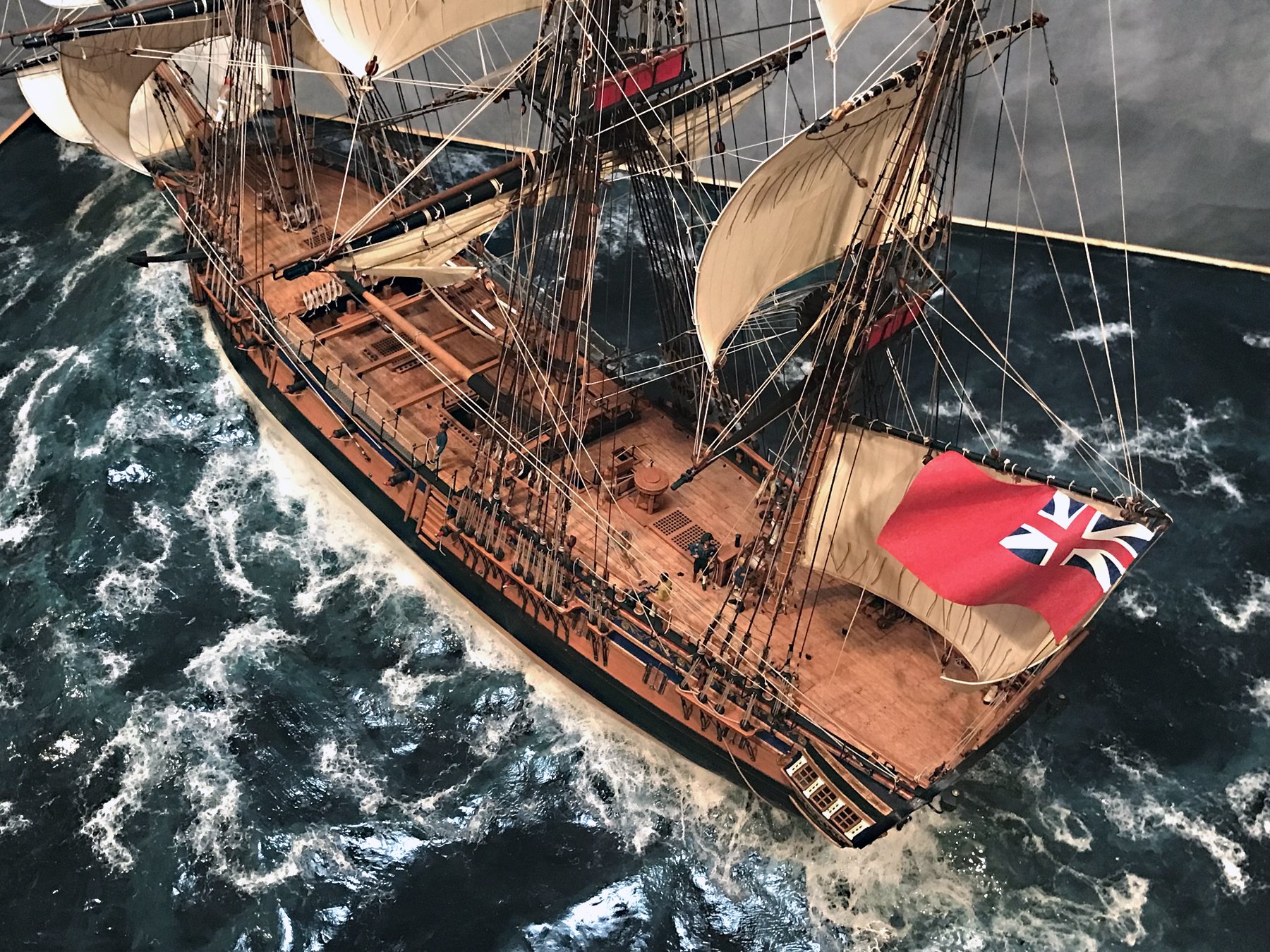
.jpg.d84ec4dad1d7791e855dca06210ab6f3.thumb.jpg.f45209242e851d4409eca1a09293165b.jpg)

